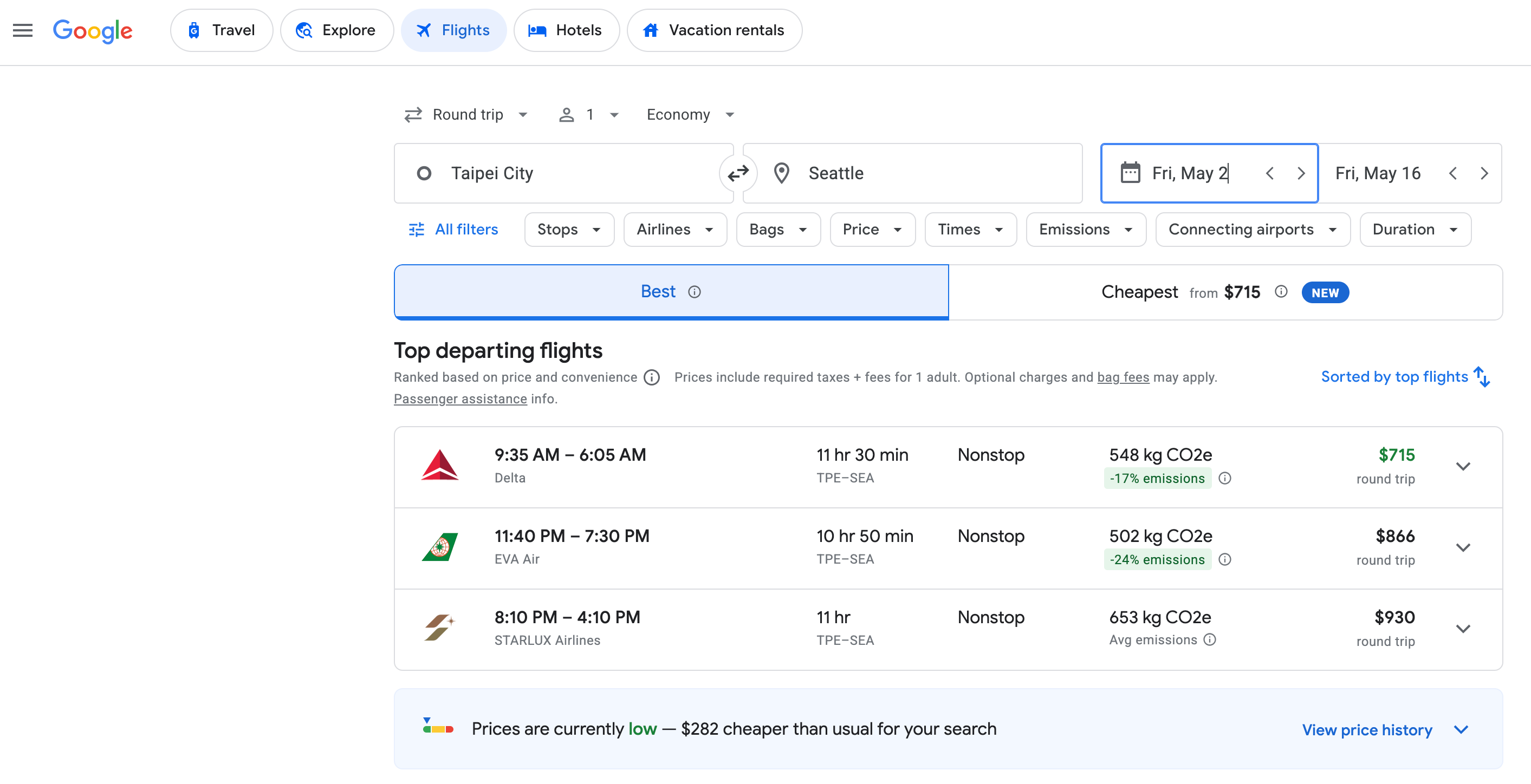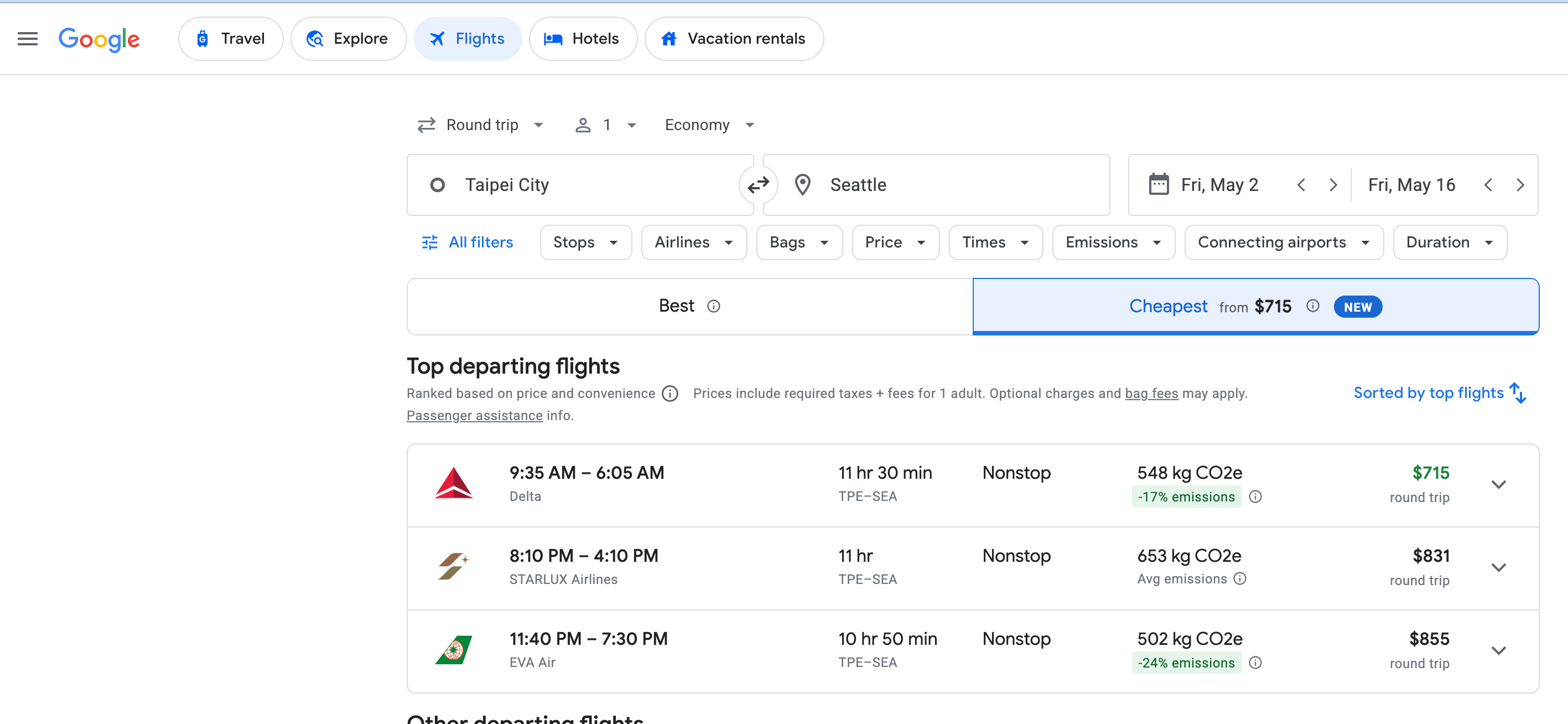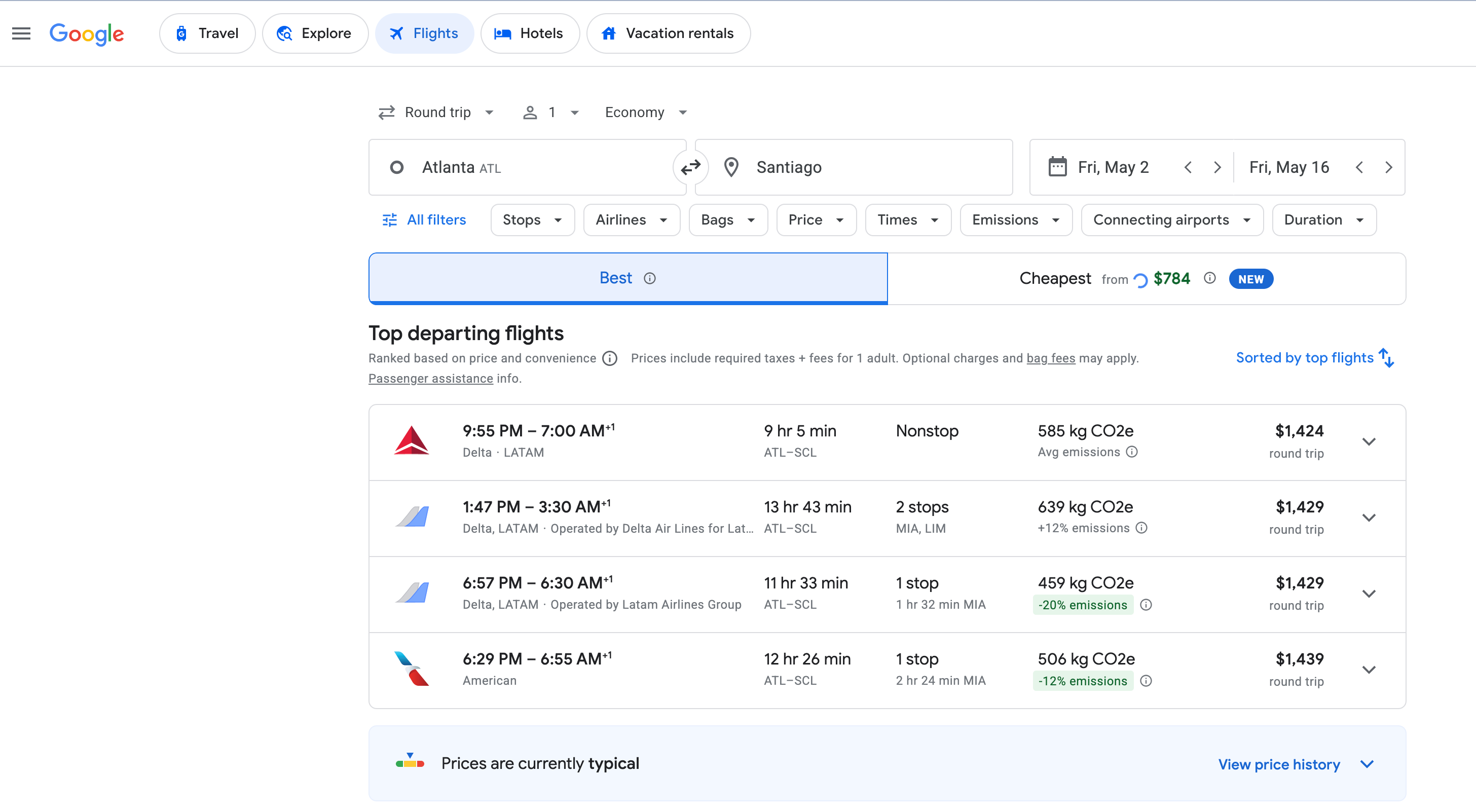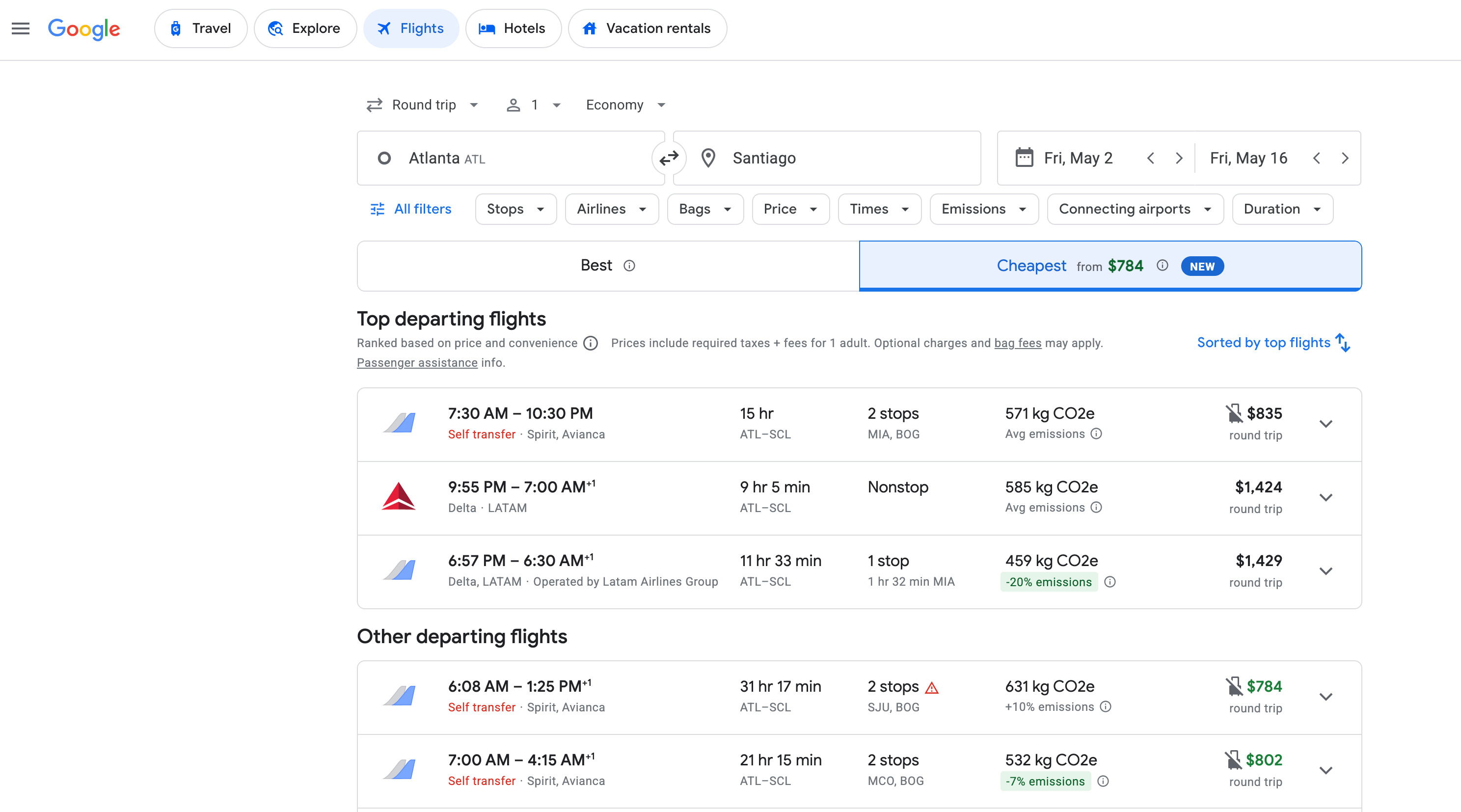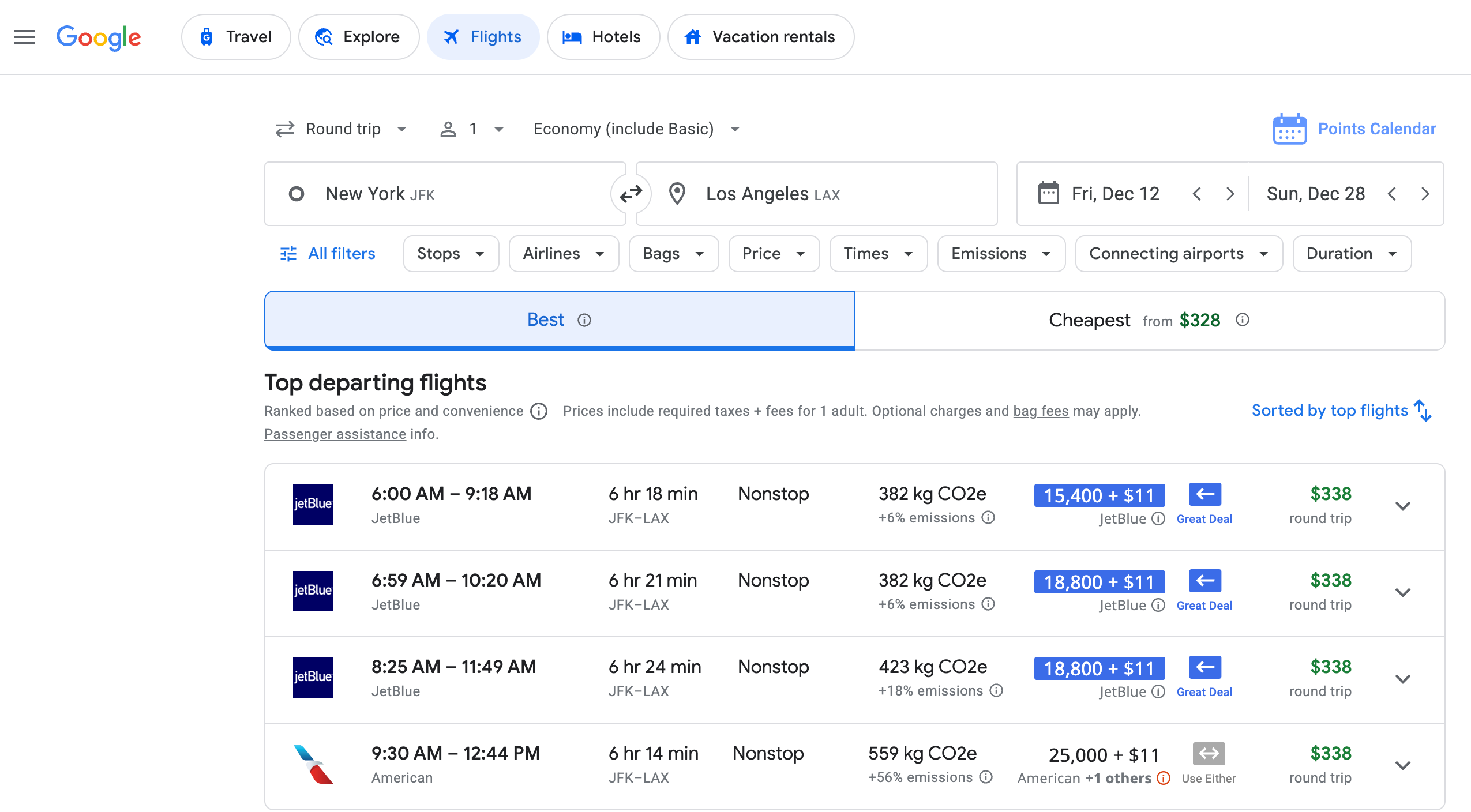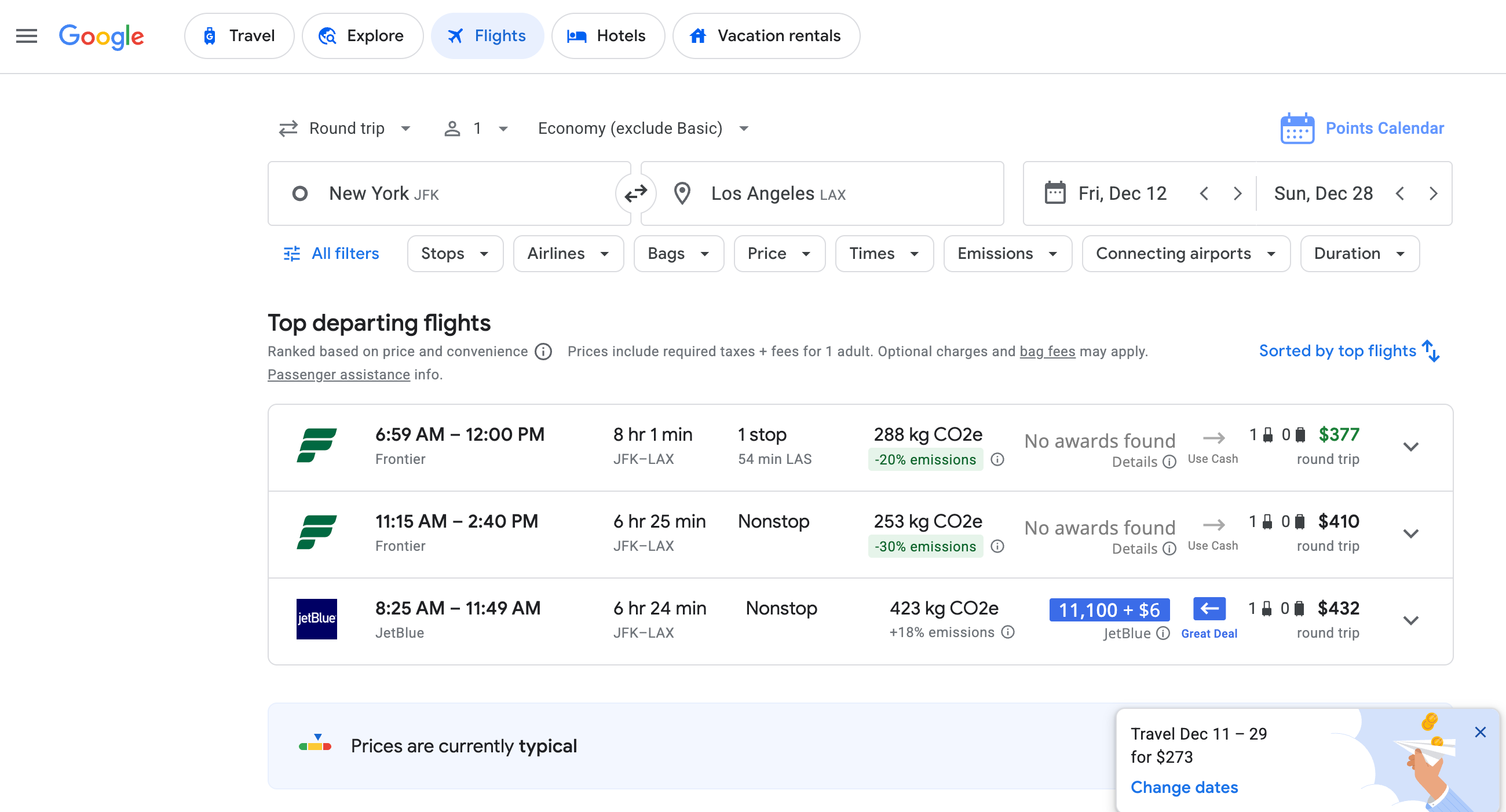Google Flights is constantly evolving, but it remains the one tool I always mention when people ask me how to find better flight prices.
This easy-to-use website can help you find the best possible price on airfare (and even hotels). It’s one of the best weapons in our arsenal at TPG to help save money on travel. TPG does post deal alerts — but if you’re looking for a particular flight, destination, airline or routing, Google Flights is the way to find personalized deals.
Google Flights just unveiled a great new tool that lets you filter out basic economy fares, too. That makes Google Flights even better.
Google Flights is where I almost always begin my search for new bookings. I come back to it again and again to book trips, see if prices have dropped and check if I can get a better deal.
The site has rolled out a feature in the search pages where you can find the “best” or the “cheapest” flights, which I’ll break down a bit more below. I’ve also written a complete guide to Google Flights Explore, an incredible feature within Google Flights.
Here’s everything you need to know to use and master Google Flights.
What is Google Flights?
Google Flights is one of our favorite tools for finding deals on flights. It’s an amazingly powerful flight search engine and super easy to use. Google shows you nearly all available flights for a search, but doesn’t force you to book with it.
Unlike Expedia, Orbitz, Tripadvisor or Kayak, it’s not an online travel agency. Google is simply showing you what’s available. Once you find the flights you like, you can “click through” to actually book. You can choose to book directly with the airline or via a third-party OTA, but not Google itself.
Google Flights now shows you ‘Cheapest’ and ‘Best’ flights
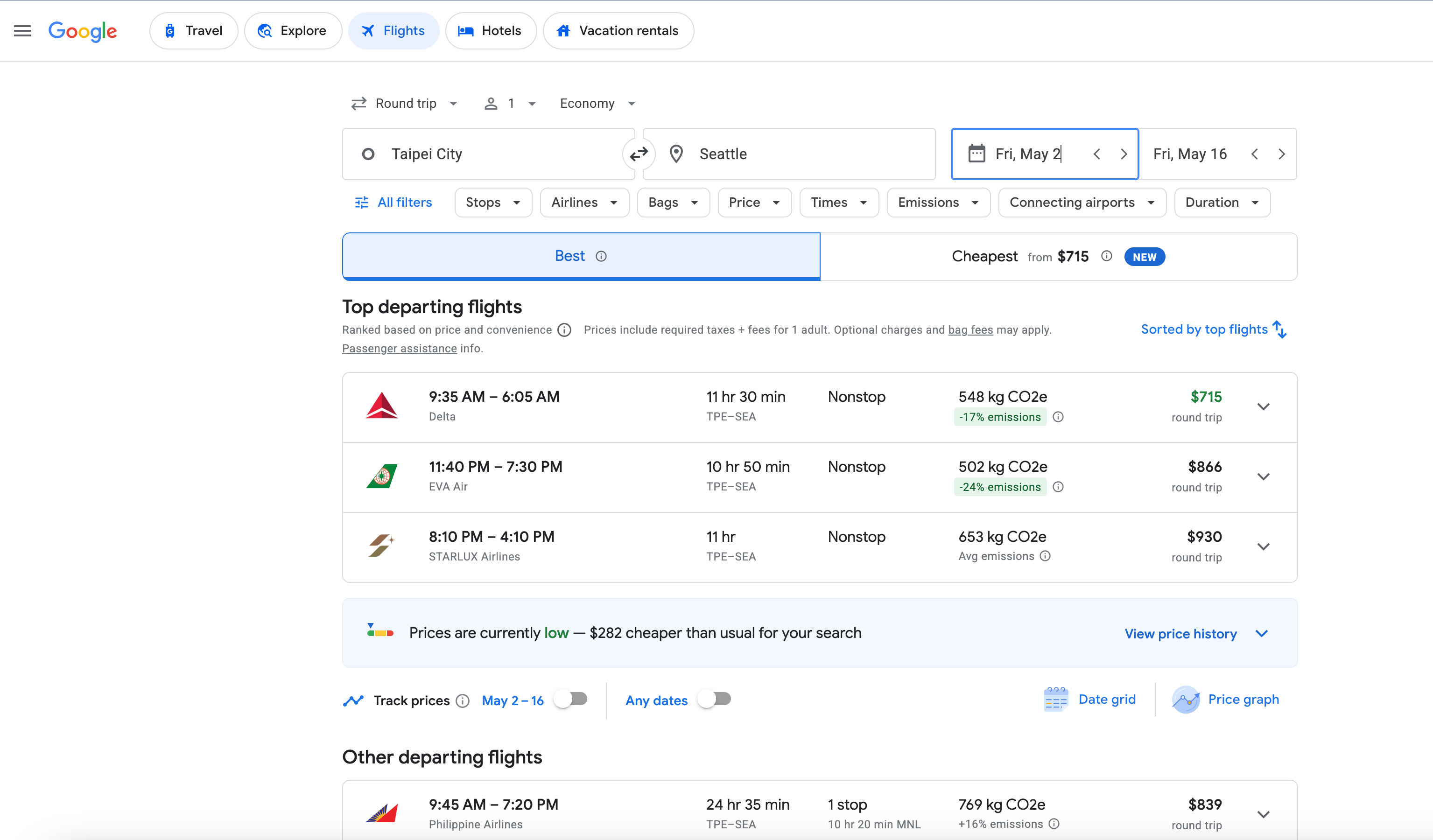
When you search Google Flights, a tab just above the results will show you either the “Best” or “Cheapest” flights.

Reward your inbox with the TPG Daily newsletter
Join over 700,000 readers for breaking news, in-depth guides and exclusive deals from TPG’s experts

Google describes the best flights as those “chosen to balance price and convenience, taking into account factors such as duration and number of stops to keep your journey smooth and affordable.”
Meanwhile, its cheapest flights category comes with the following caveat: “These additional budget picks help you save but may involve trade-offs, such as flying back to a different airport in the same city you departed from, self-transferring luggage, or booking via a third-party site.”
Sometimes, these categories overlap. For example, check out the options for this trip from Taipei, Taiwan, to Seattle. Google lists nonstop flights on airlines like Starlux Airlines, Delta Air Lines and EVA Air as the best flights; when you toggle over to the cheapest flights, you’ll see the same flights displayed again. In this case, the best flights are also the cheapest.
1 of 2
Google Flights search from Taipei to Seattle. GOOGLE FLIGHTS
However, you will sometimes see vastly different results on different itineraries. Here’s an example search from Atlanta to Santiago, Chile. When I start on the best flights, the cheapest option is a direct flight on Delta for more than $1,400 — but once I’ve clicked over to the cheapest tab, I can find flights as low as $784. I personally wouldn’t want to have to fly different carriers with multiple stops, but your mileage may vary.
1 of 2
Google Flights search from Atlanta to Santiago. GOOGLE FLIGHTS
Anyway, play around with these features and see how much you can save.
Google Flights now lets you screen out basic economy
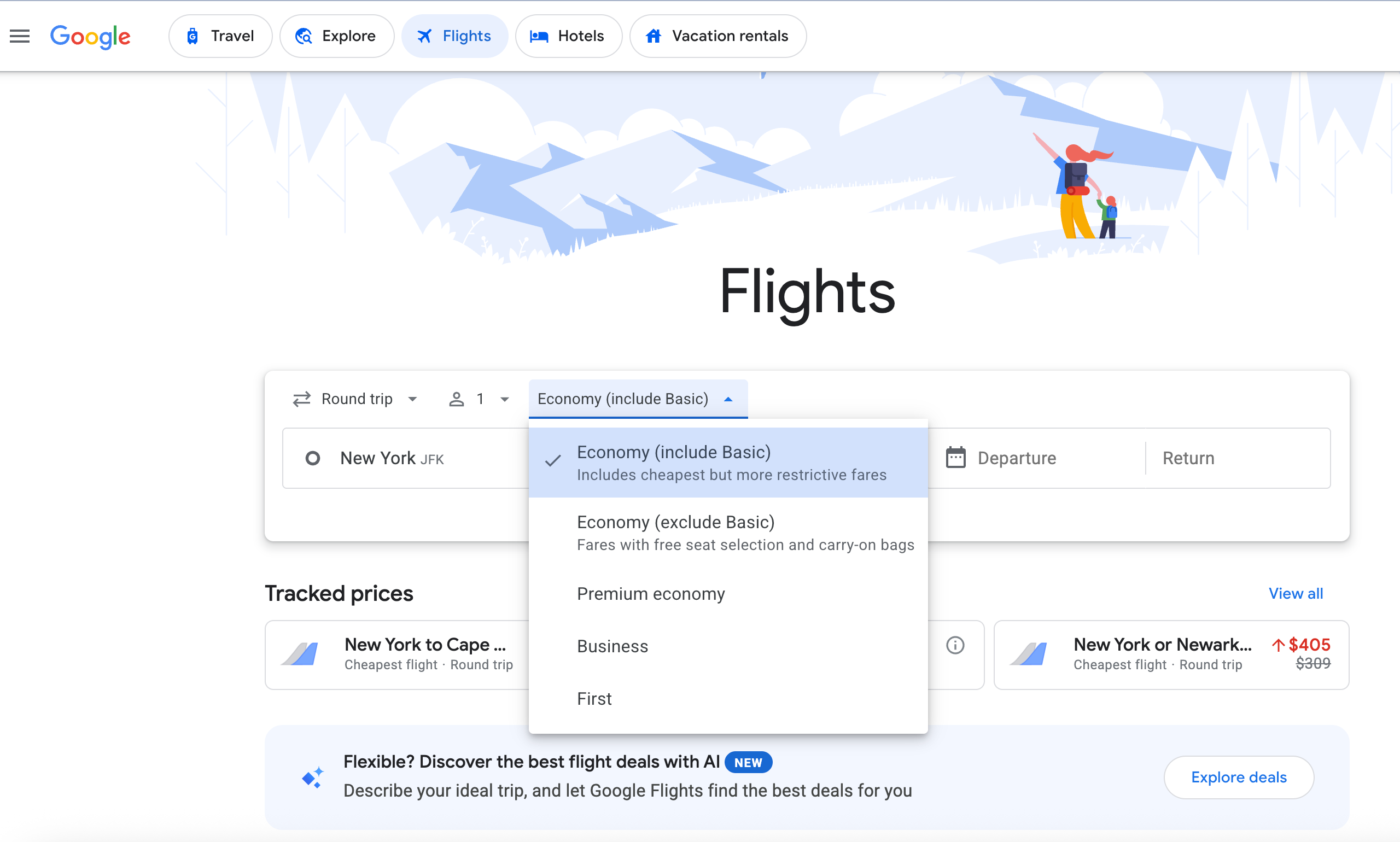
As you can see in the screenshot above, you can now filter out basic economy fares. It’s a feature that we wanted for years, and Google has delivered. Simply click on the fare class tab in your initial search for a drop-down menu where you can select “Economy (include basic),” “Economy (exclude basic)” or premium-cabin filters.
This saves me a lot of time, as I usually won’t book basic economy fares because of all the restrictions.
Here is a side-by-side comparison of a flight search for New York to Los Angeles. If you include basic economy, you’ll find flights as cheap as $338 round-trip, but if you exclude those cheapest seats, the price jumps to $377 (still not a bad deal!).
1 of 2
Google’s new filter to screen out or include basic economy fares. GOOGLE FLIGHTS
Some other fairly new features at Google Flights
Google has also introduced features that suggest when prices are historically lowest and when you should book for maximum savings. Google has always shown whether the price for a suggested flight itinerary is typical, low or high, but now it gives you even more data to consider.
According to Craig Ewer, who works in communications at Google, the tool will “let travelers know when airfares are expected to be lowest for booking their chosen dates and destination.”
For example, when I searched last year, Google showed me that a flight from New York to San Francisco in October was $93 cheaper than usual and that the typical range is between $245 and $415. In other words, it was a good time to book.
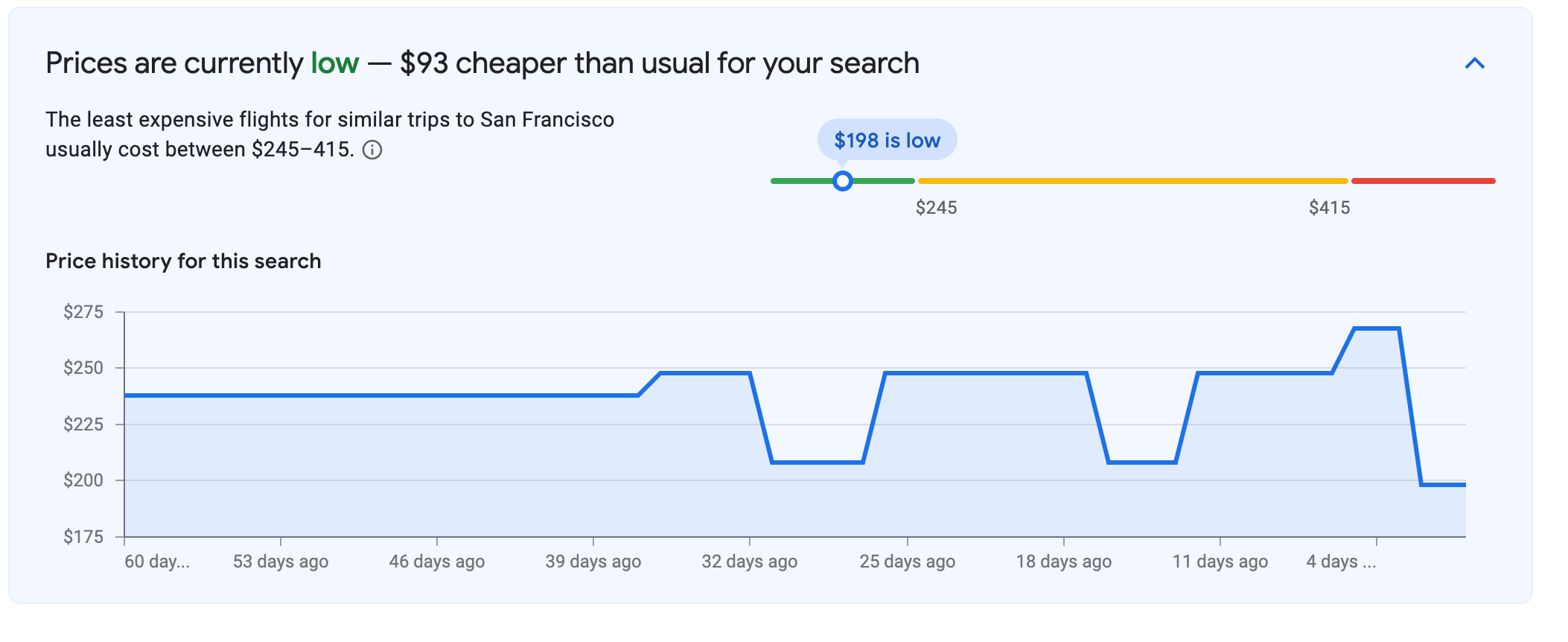
It gets even better: In some situations, Google will suggest alternate dates to help you save a few bucks. The example below shows that a December flight to Miami would have been much cheaper if I had waited until Sept. 13 to book it.
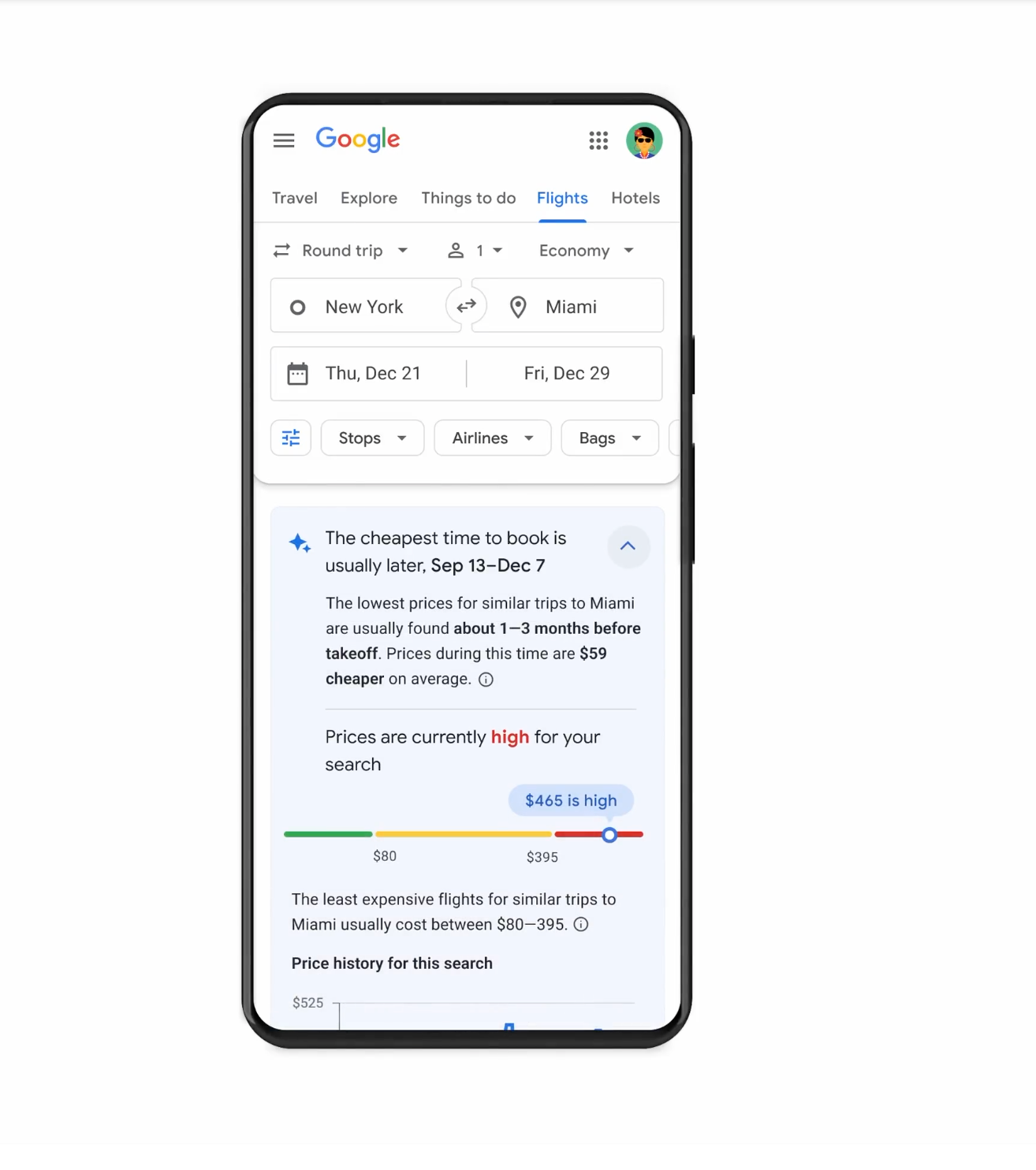
Basics of Google Flights
How to perform a basic flight search
First, you’ll want to navigate to Google Flights.
The toolbar has additional features for trips, including things to do, hotels, vacation rentals and a shortcut to that cool tool I mentioned earlier called “Explore.” However, we’ll focus on using the main tool to book flights for now.
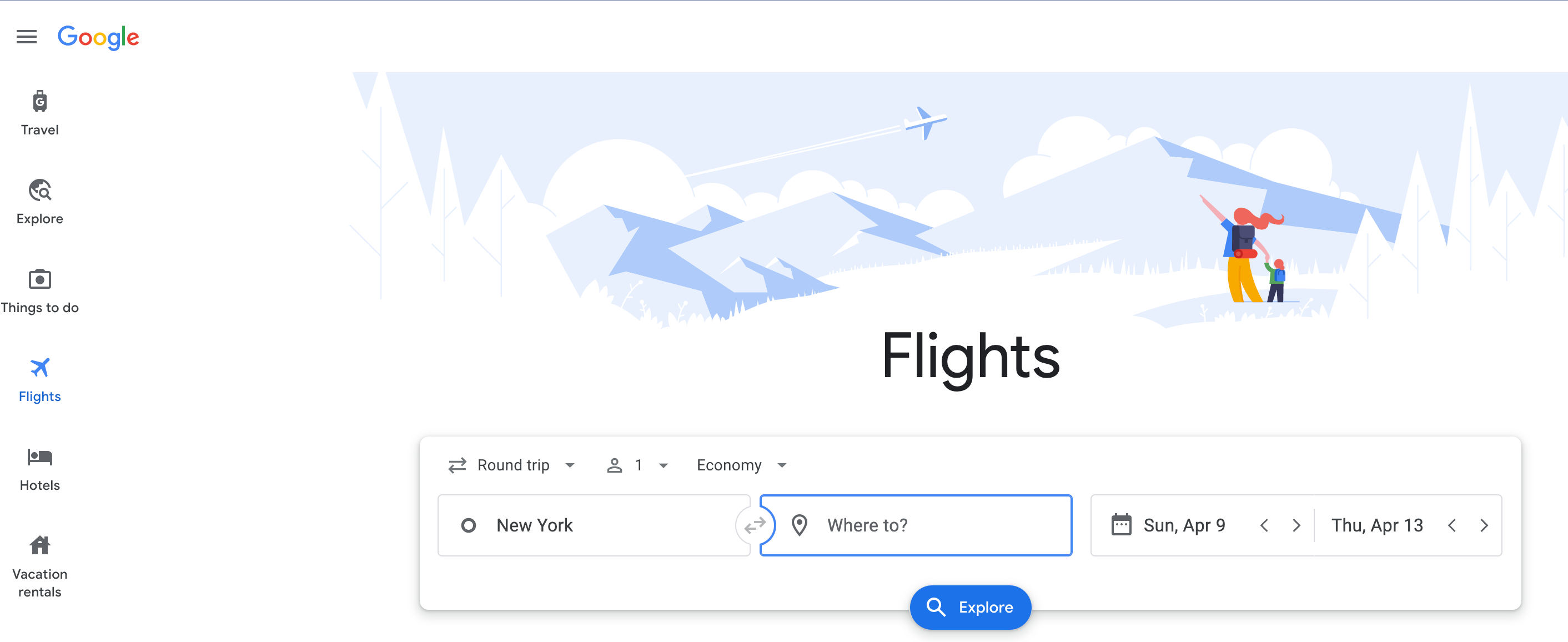
All of the fields and drop-down menus on this page are relatively easy to decipher:
- Departure (where you want to fly from)
- Destination (where you want to fly to)
- Date(s) of travel
- Round-trip flights, one-way flights or multicity trips
- The number of passengers (but you should search for a single ticket, even if you’re traveling in a group)
- Ticket class (economy, premium economy, business class or first class)
If you know where you’re going and when you want to be there, all you have to do is plug in that information.
For example, here are all the options I see when I search for flights from New York City’s John F. Kennedy International Airport (JFK) to San Francisco International Airport (SFO). You can search by destination or by airport code.
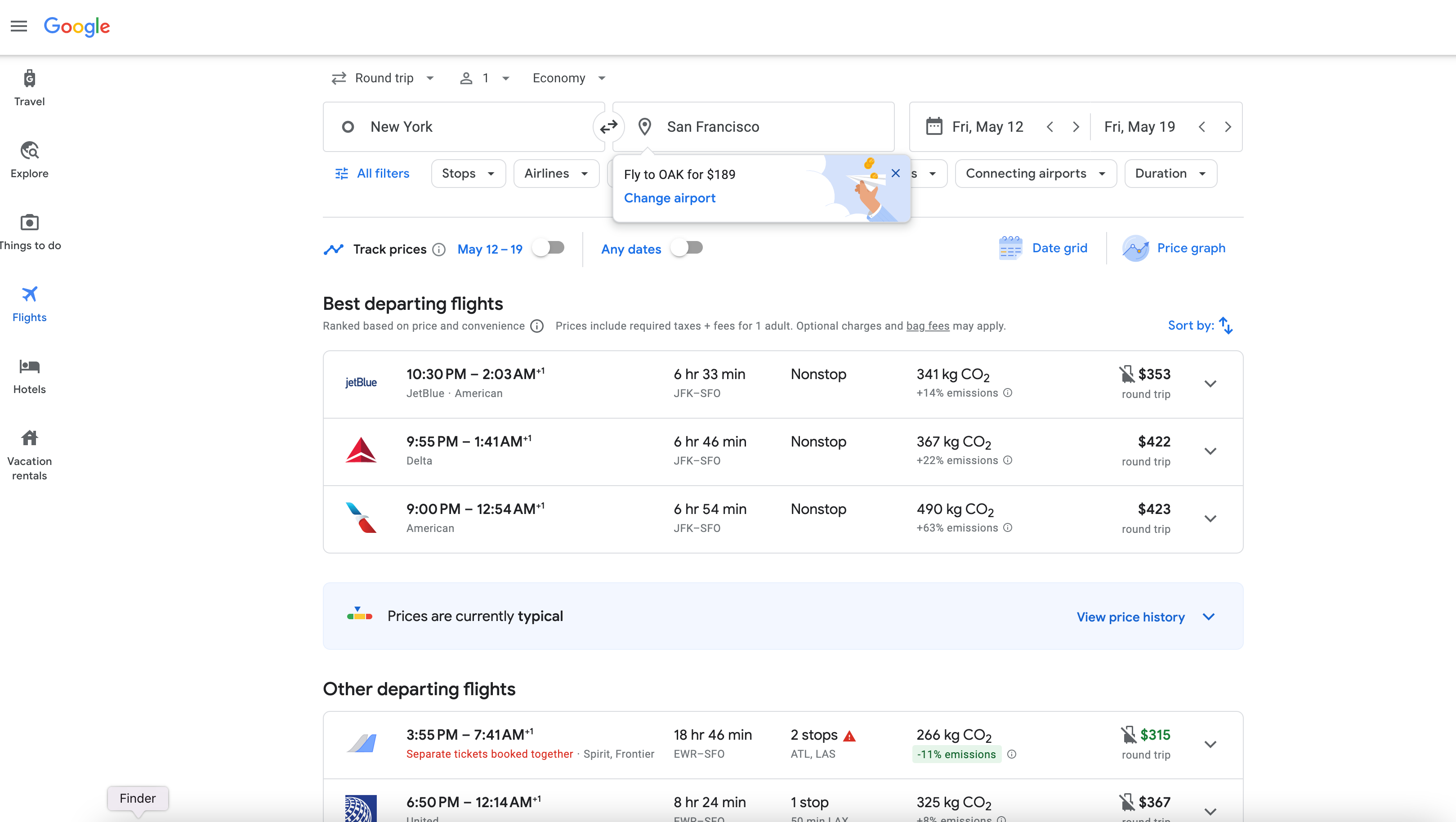
Note that as mentioned, Google automatically displays what it considers the best flights based on a combination of factors, such as price, convenience of the route, number of stops and travel time. Of course, these may or may not be the best flights for you.
Regardless, there are plenty of options to choose from.
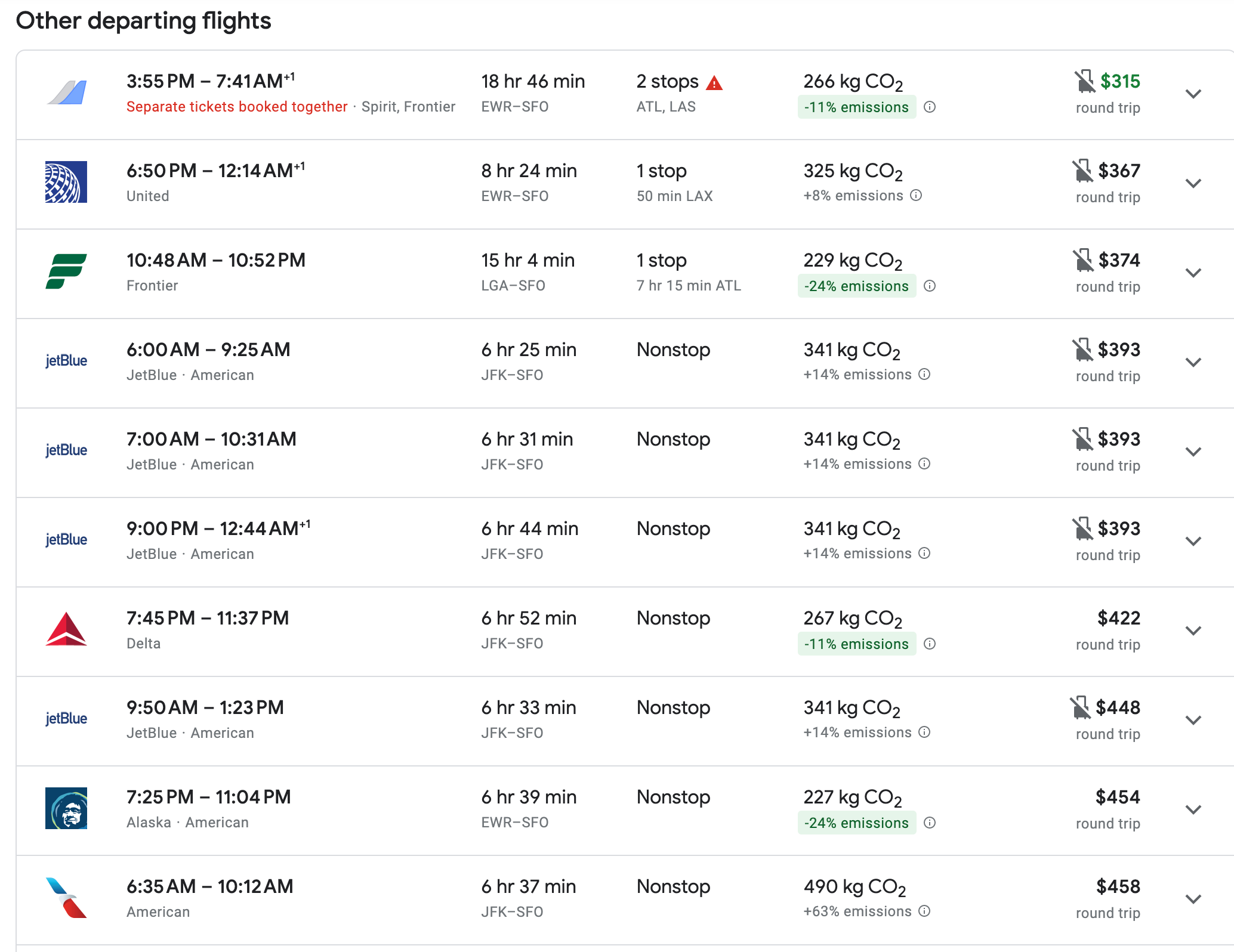
Once you’ve found the flight you want, you have the option to book directly with the airline. Google will give you several options for the type of ticket you want to purchase, including basic economy, refundable and other types of fares.
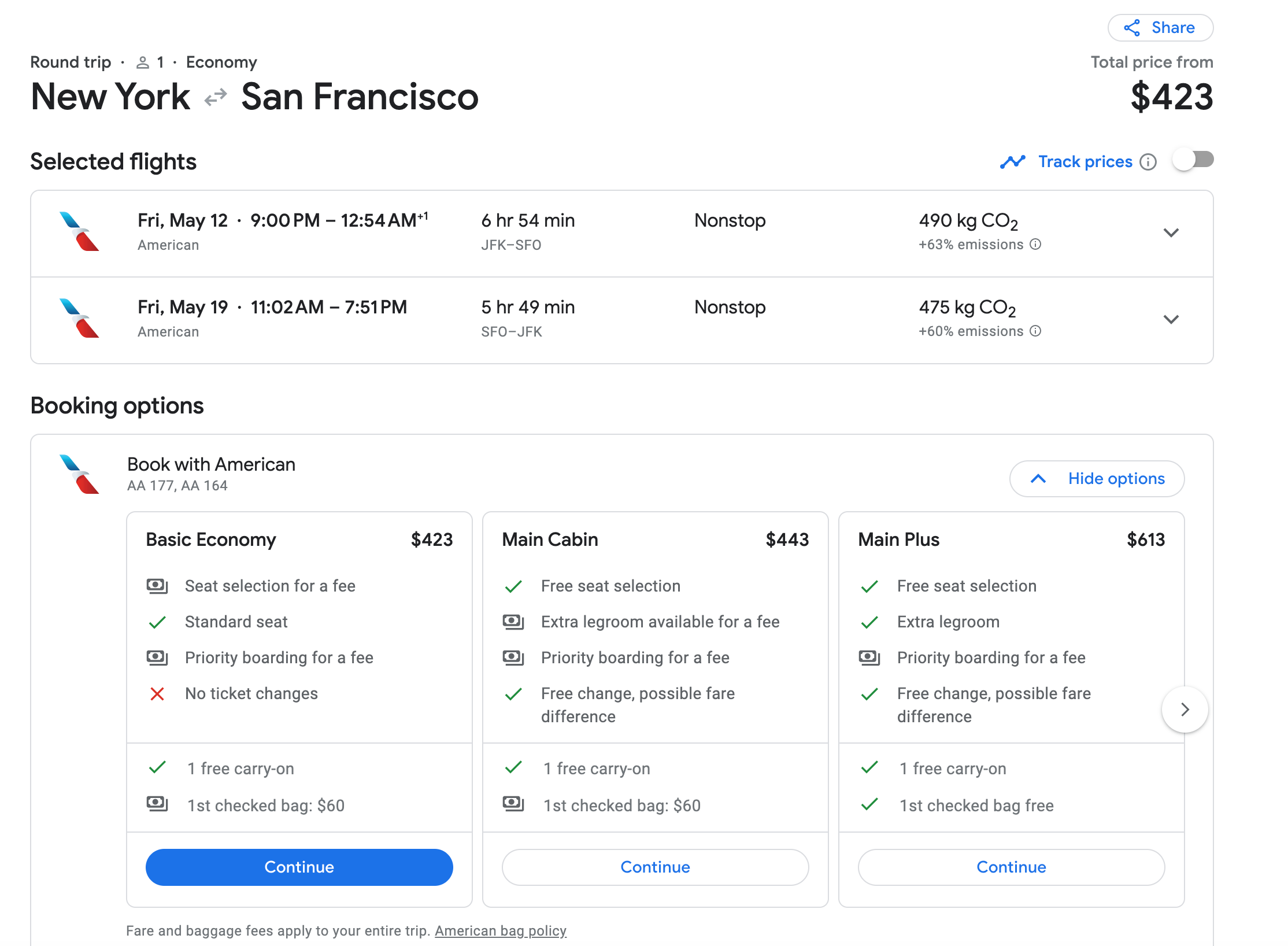
Clicking the blue button would take me to the American Airlines website, where these flights and prices would be preselected for me. There, I could enter my passenger details and loyalty number, select a seat, and pay for the ticket.
Sometimes, the cheapest option is to fly the return trip on a different carrier. However, Google Flights clearly indicates that two tickets must be purchased separately.
For example, in the itinerary shown below, the cheapest option involves mixed tickets with multiple stops. Most people are not going to want to take that option, as it involves booking through a third-party website (so you won’t get the perks you’d get when booking directly with the airline) with tickets on different airlines and multiple flights and layovers. No thanks.
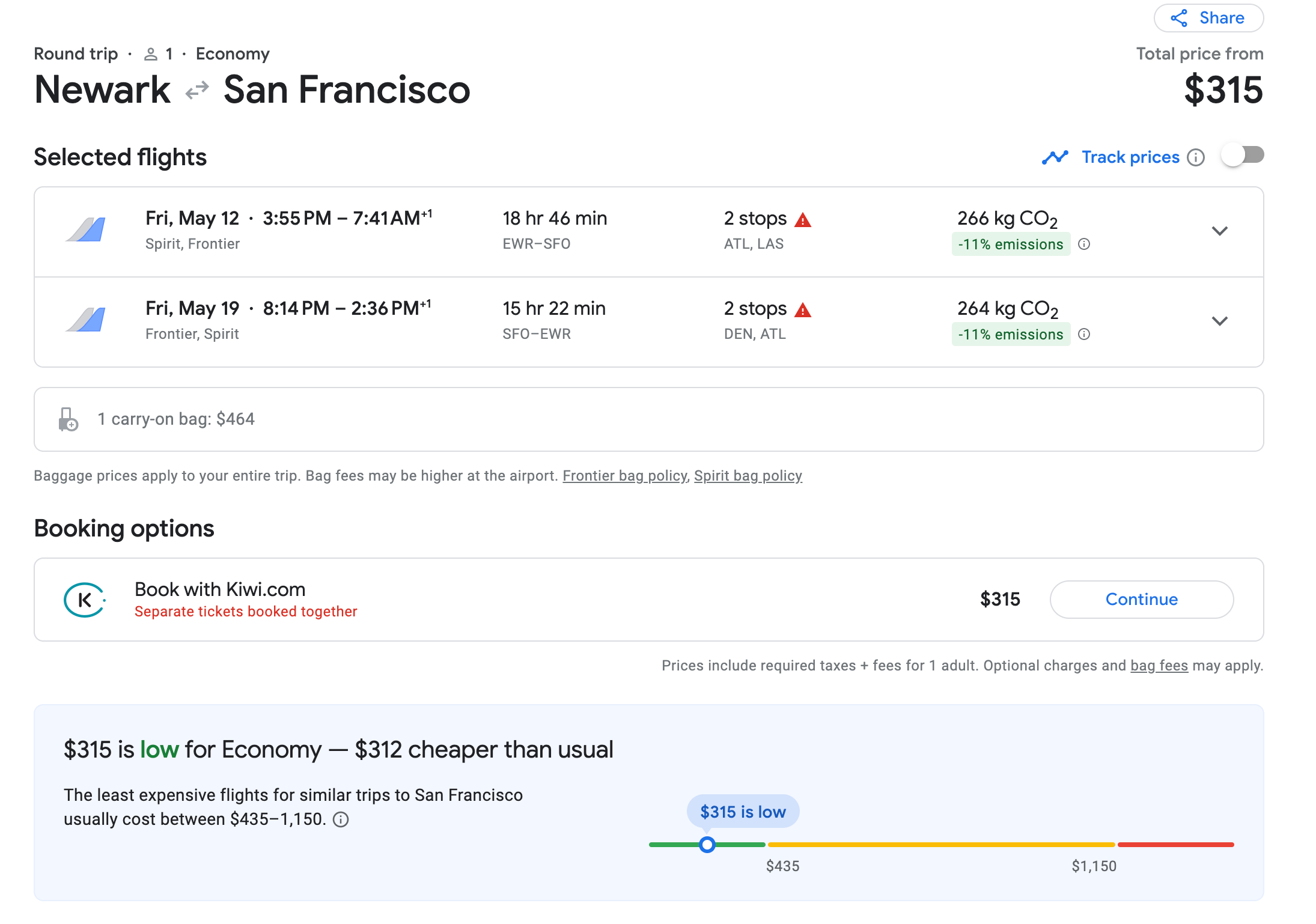
Related: Things to consider when choosing to book via a portal vs. booking directly
There are many ways to filter your searches. We’ll explore that a bit more below.
Search by specific times of day
Say you want to take a weekend trip. You need both flights to occur outside business hours, but not too late in the evening, as you don’t want to land in the middle of the night.
Thankfully, Google Flights lets you filter by time of day to find the flights best for your schedule. No matter how inexpensive those off-hours flights may be, a 3:30 a.m. wake-up call or arrival rarely feels worth it.
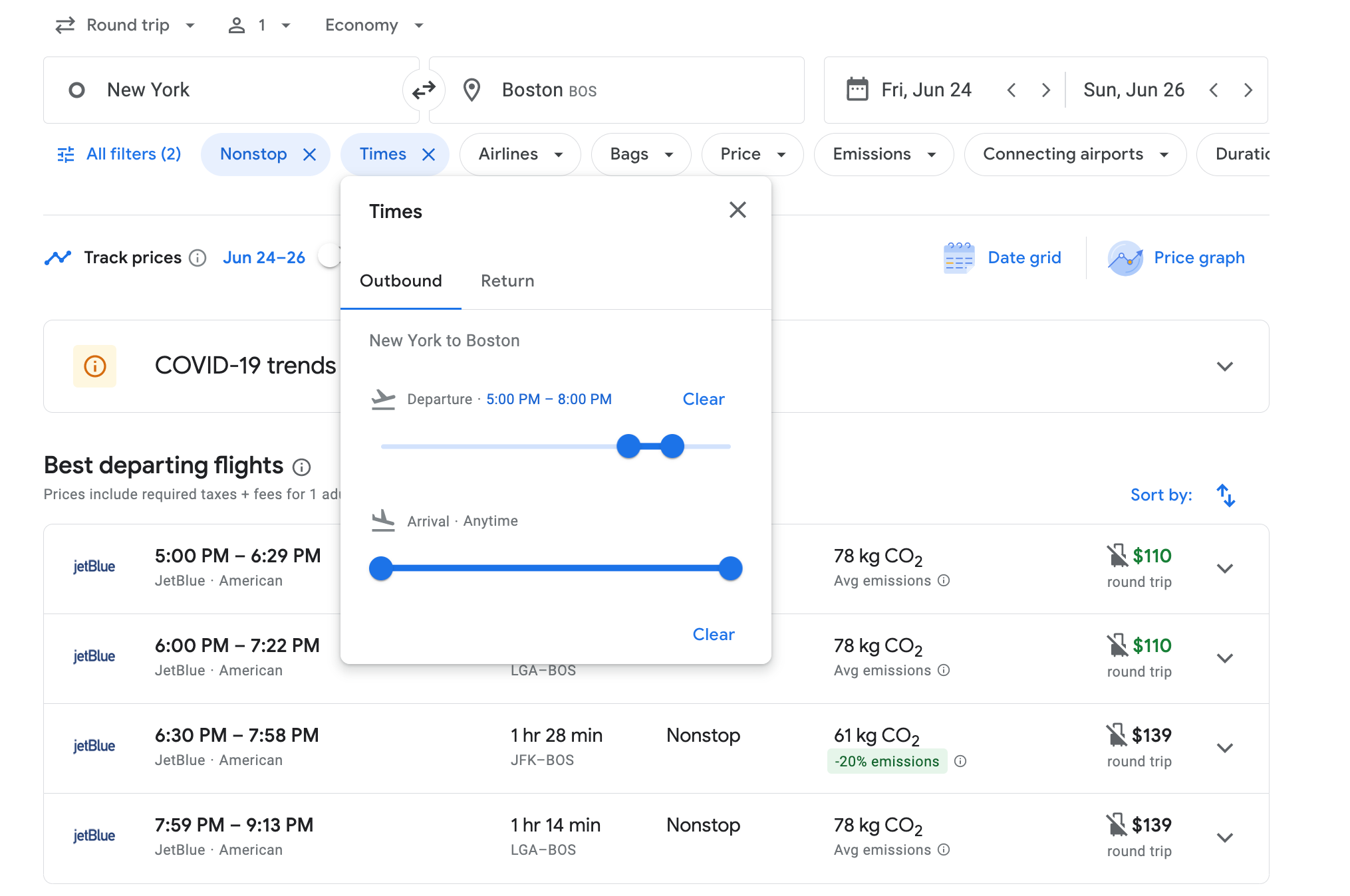
See how many bags you can bring on board
In the same series of buttons below your Google Flights search, click the “Bags” button to specify how many pieces of luggage you want to bring on board.
This selection may greatly limit your search results — or drive up your price options — so be prepared for some flexibility if necessary.
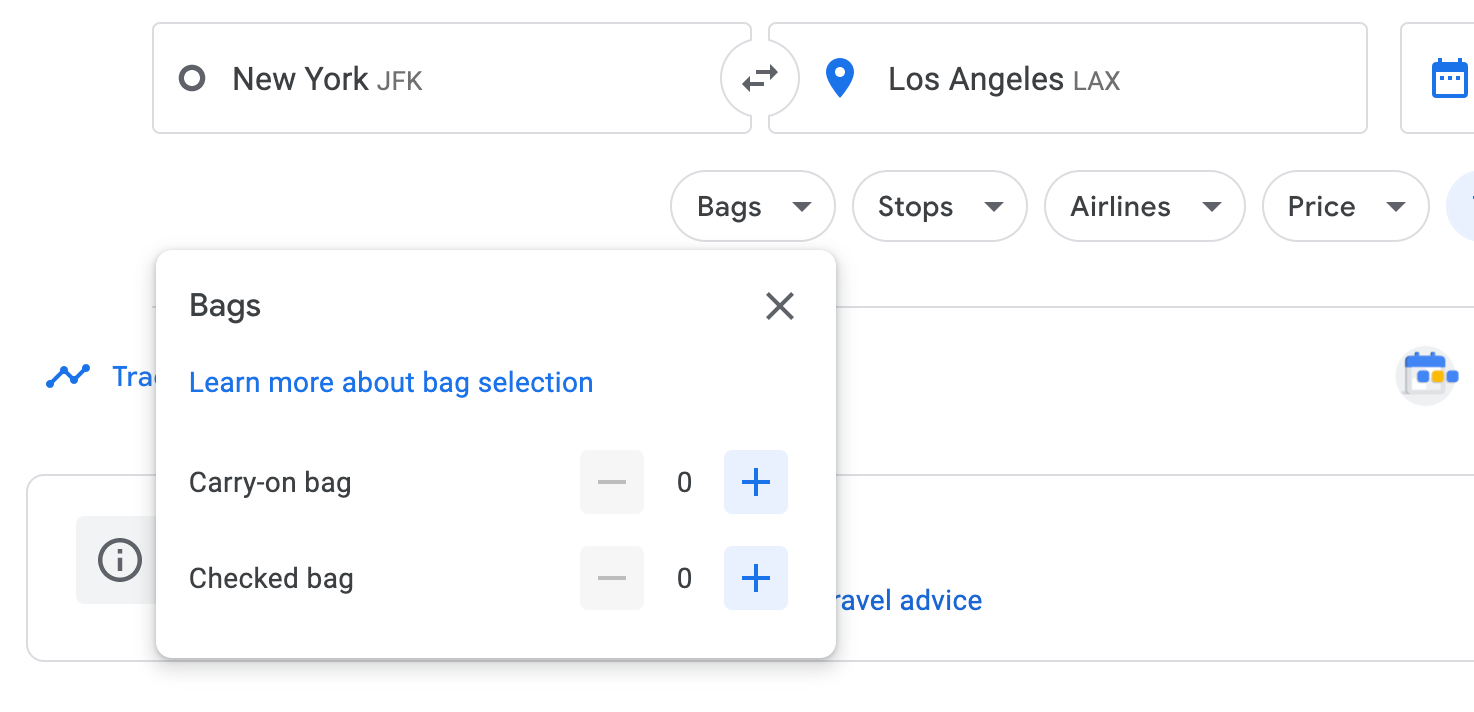
Nonstop, one-stop or any flight will do?
Similarly, you can filter flights by the number of stops along the way. Sure, you might be the glutton for punishment who longs for a 50-plus-hour flight with multiple layovers. However, if you want to minimize the chance of delays or disruptions, have a family to rush back to, or just want a shorter flight, nonstop is your friend.
Headed overseas? A one-stop flight will usually be the sweet spot between price and comfort.
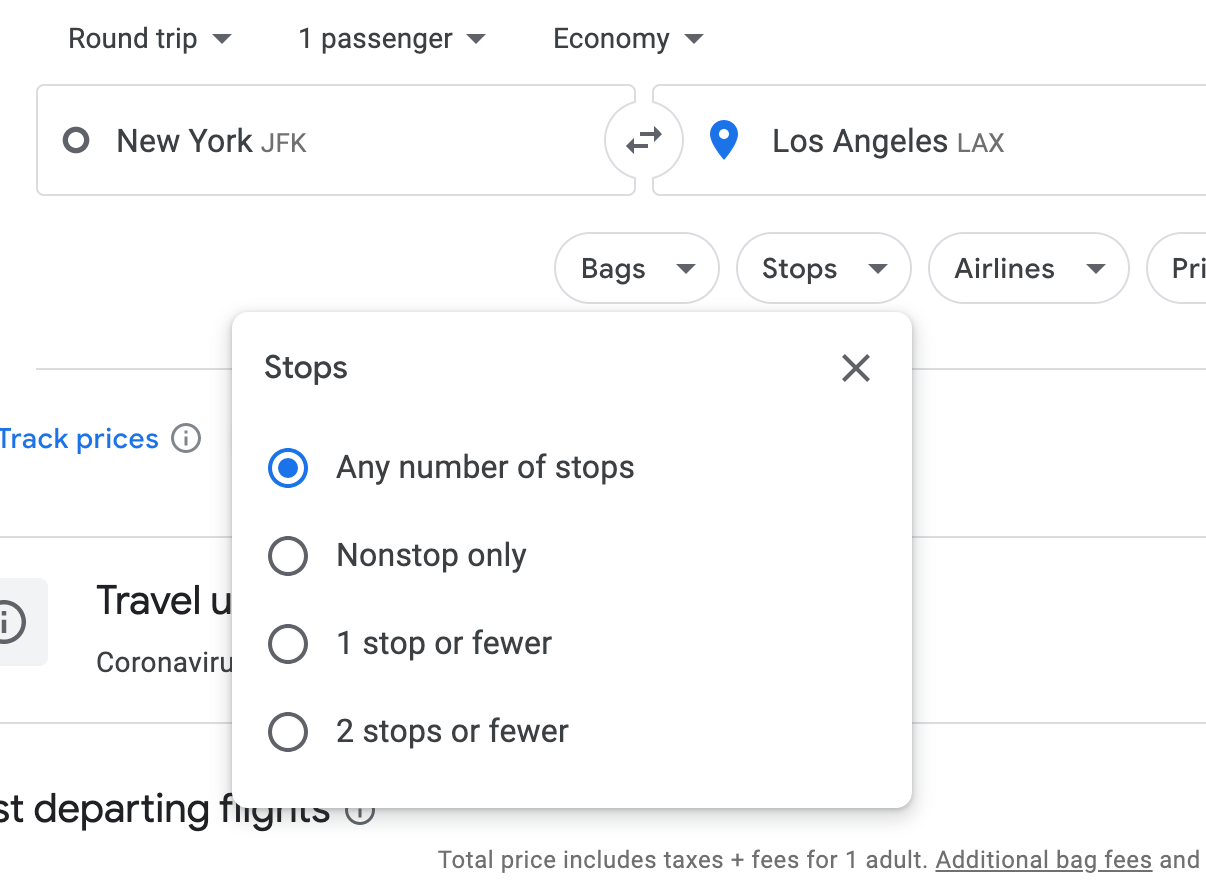
Search for flights from your preferred airline or alliance
If you don’t fly often, the operating airline may not matter to you as much as the price does.
However, if you’ve begun accumulating miles and status with a specific carrier, you may want to stick with that carrier and program. The exclusive benefits of elite status can be exhilarating, and there’s nothing more exciting than booking your first award flight — especially if you know you got an amazing deal.
With filtered airline search results, Google can help you keep that momentum going. Use the button under the search results to filter out unwanted airlines or select specific airline alliances you want to patronize. Or, you can simply turn off the “Select all airlines” option and manually select your preferred carriers.
Whether booking with cash or points, you may want to stick with one program to maximize mileage earning or status. For example, if I were trying to hit Diamond on Delta Air Lines, I would search only for Delta flights.
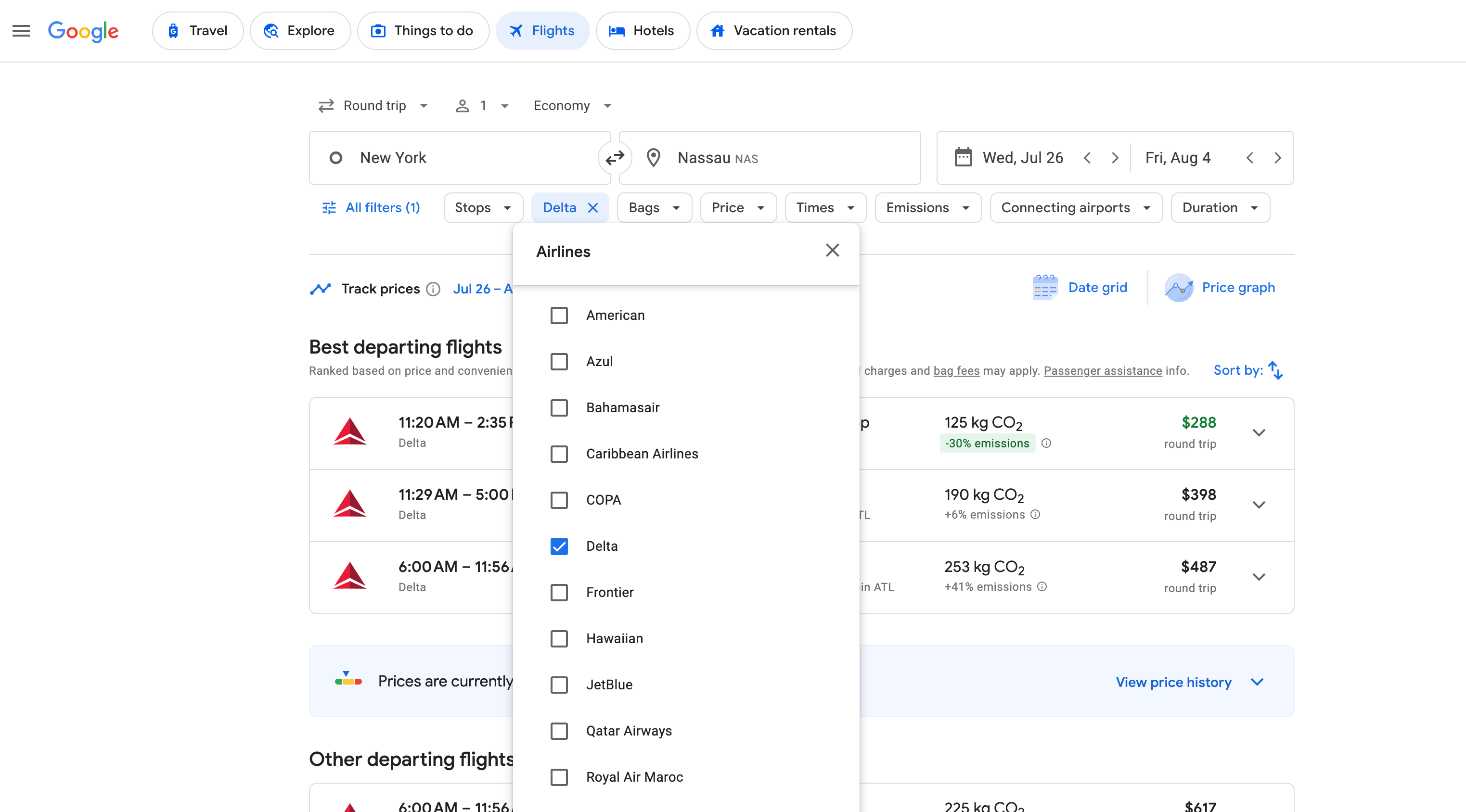
You can also pick airline alliances like Oneworld and SkyTeam to ensure you travel on your preferred airline or its partners. In this case, I would select SkyTeam.
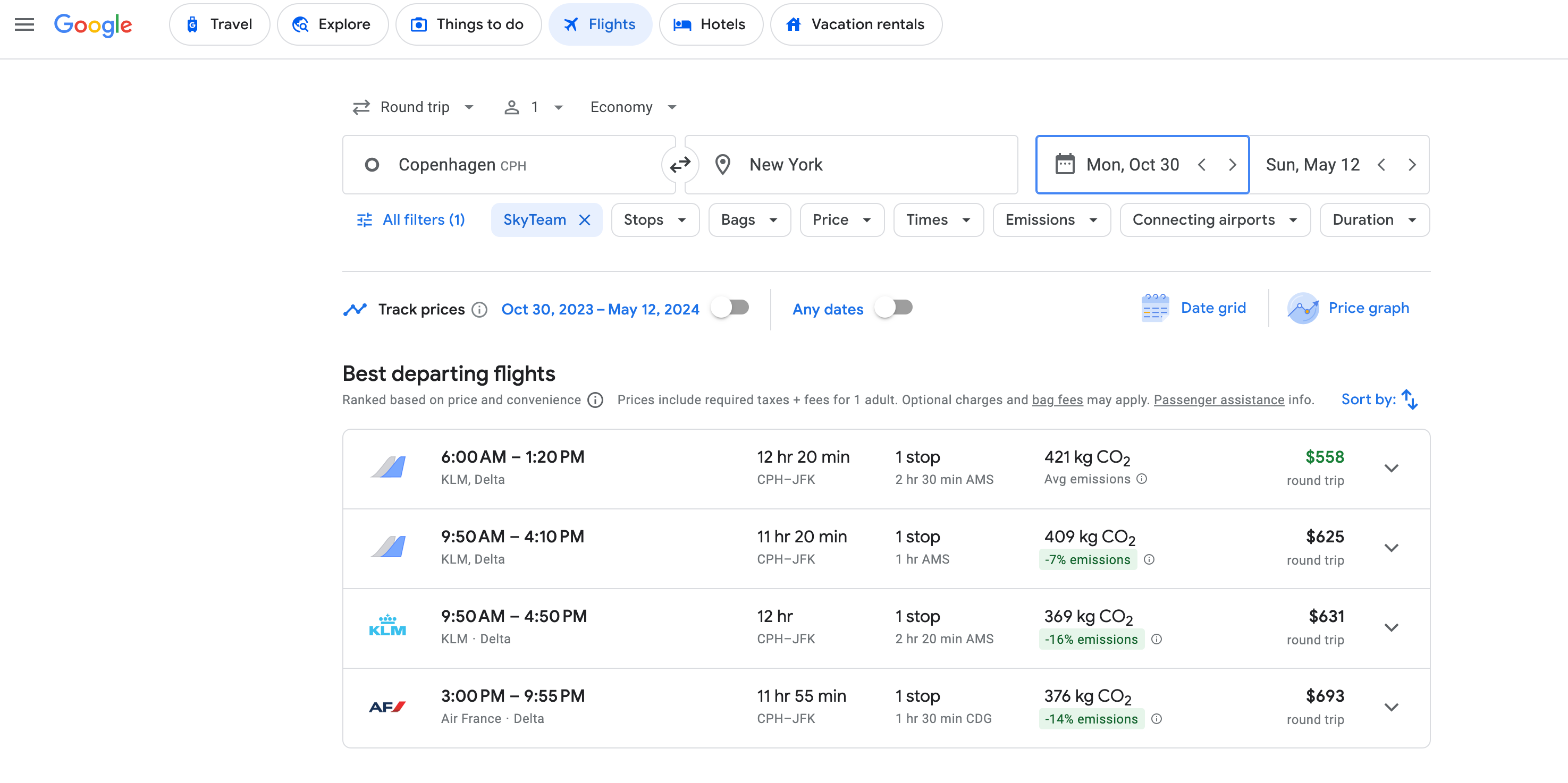
Connecting flights
You can also decide if you want to fly nonstop or how many stops you are willing to make, and you can even choose the connecting airport.
Some airports are better to connect in than others, especially for international flights. For example, Helsinki Airport (HEL) is lovely; on the other hand, Paris-Charles de Gaulle Airport (CDG) and Amsterdam Airport Schiphol (AMS) can be challenging even for the most experienced travelers.
If there are many flight options from, say, New York City to Rome, with a choice of connecting airports, you can filter the results to only show the airports you want to connect through.
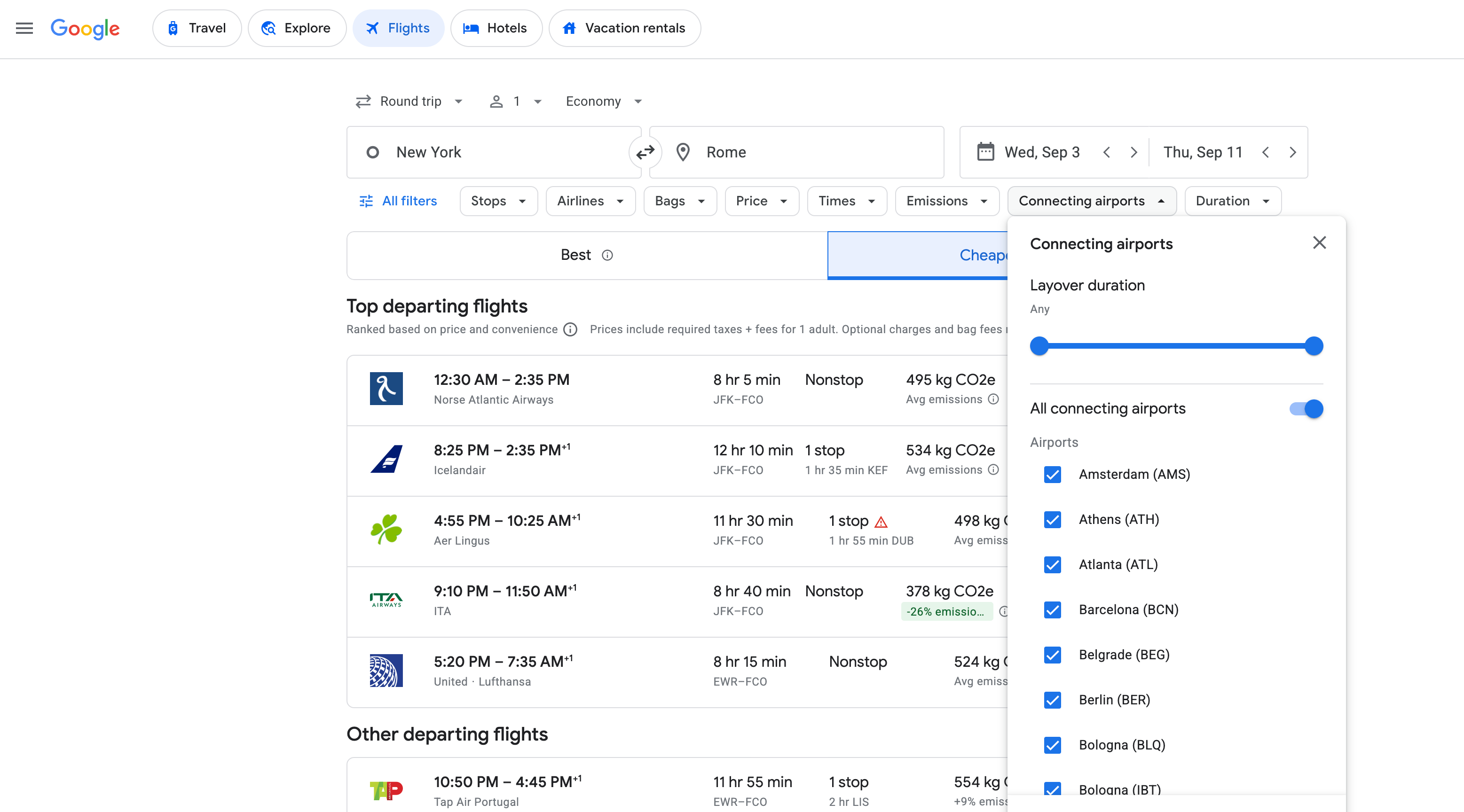
You can also choose how long you would like your layover to last. You might want to keep it short to reach your destination as quickly as possible. Or, you may prefer a long layover to allow for some buffer time in the event of delays.
Related: How to plan a free stopover on your next trip abroad
Score the best legroom and other seat amenities

Don’t you hate boarding a flight to find your knees touch the back of the seat in front of you? Fortunately, Google Flights now shows you how much legroom to expect on your next flight before you purchase a seat.
Legroom can differ noticeably from carrier to carrier and aircraft type to aircraft type. From the search results below, you can see that Spirit Airlines’ is below the industry average at 28 inches, while JetBlue’s is above average at 32 inches.
If you value legroom, this means the JetBlue option will offer 4 inches more than Spirit. In coach seating terms, that’s a lot.
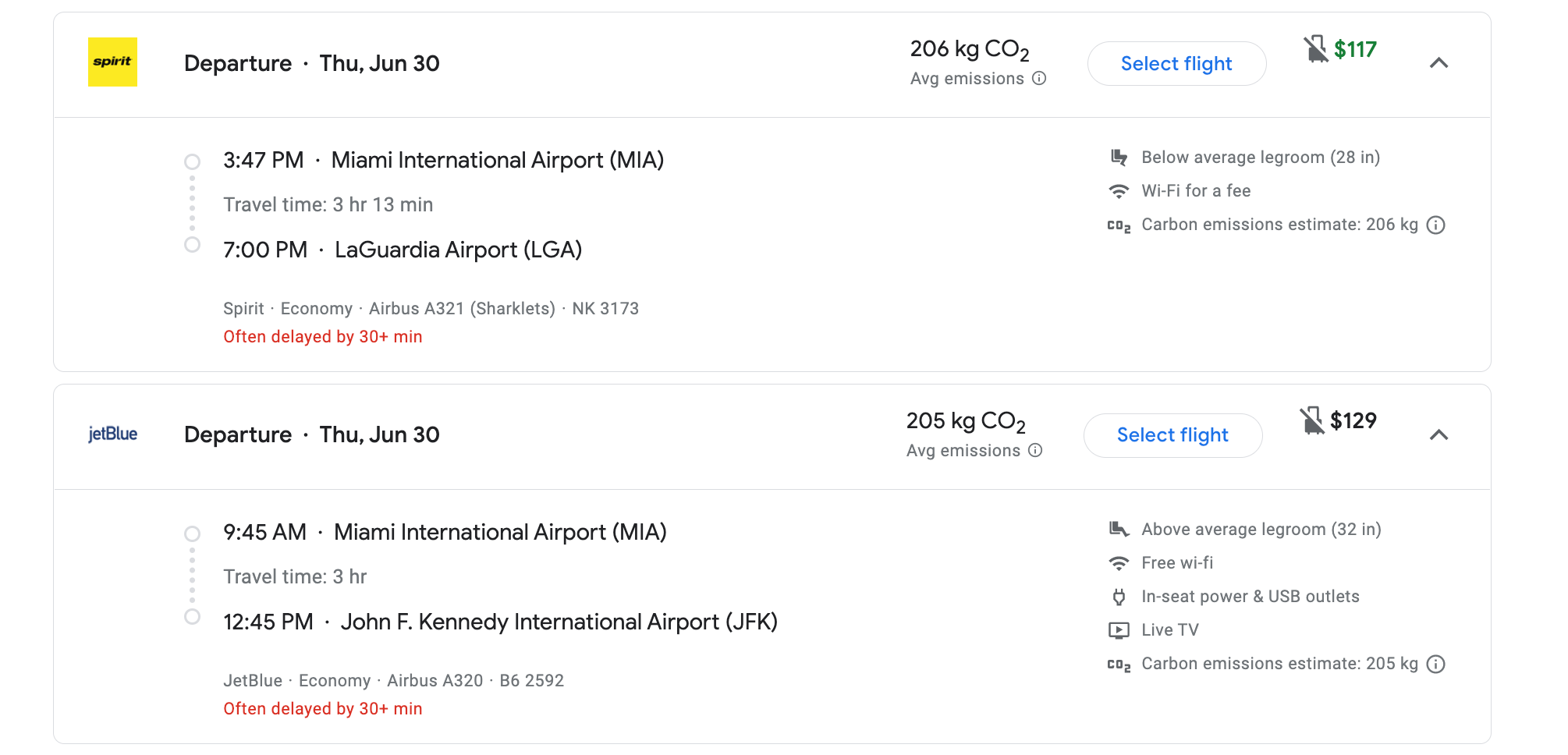
In addition to legroom, Google Flights will also indicate whether to expect Wi-Fi access on your flight (and whether it is free or at a cost), whether the plane has in-seat charging options, and whether the flight offers entertainment like live TV or options to stream to your personal device.
Your devices may run out of juice on a flight longer than five hours, so you may want to choose the product that best suits your needs rather than selecting entirely based on price or carrier.
Know your emissions
Sustainability is an increasingly hot topic when it comes to travel. Thankfully, Google Flights will calculate your flight’s approximate carbon emissions based on the route, aircraft type and seating classes.
Below are the search results for a flight from Los Angeles International Airport (LAX) to Tokyo’s Narita International Airport (NRT). United Airlines operates a fuel-efficient Boeing 787 on this route, which would produce a lower-than-average 734 kilograms of carbon dioxide. However, the Singapore Airlines flight uses a less fuel-efficient (and larger) Boeing 777 aircraft that produces a higher-than-average 1,163 kilograms of carbon dioxide.
You can even filter your search results only to show lower-emissions flight options.
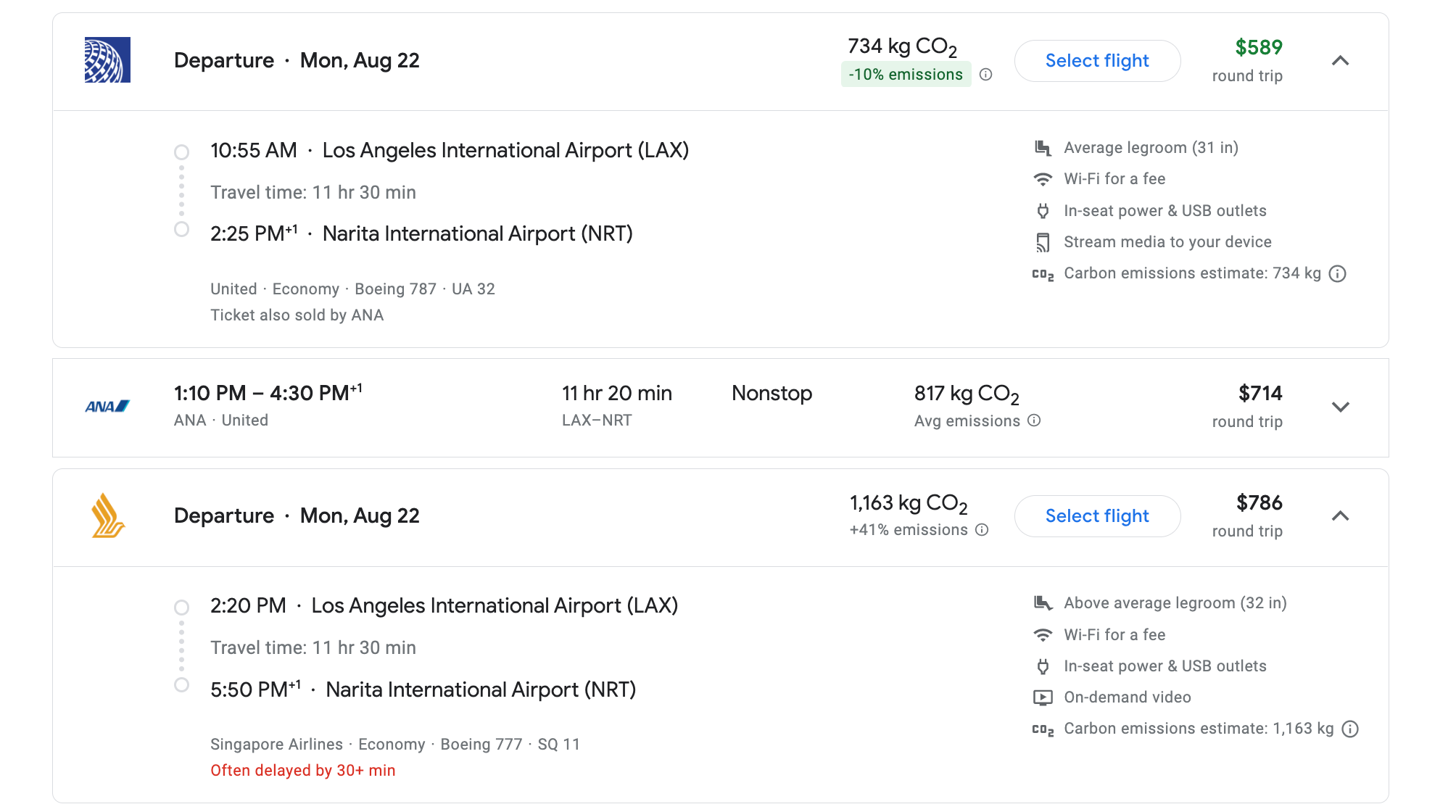
How to search by cheapest dates
Let’s say I want to get from JFK to LAX in September, but I’m not tied to any specific dates. Google Flights can help me find the best possible prices for that trip.
On the search page, if I click on the calendar icon, I can see the lowest price for that particular day. Prices listed in green represent the lowest price available across all current dates, while the days highlighted in blue show which dates I’ve selected.
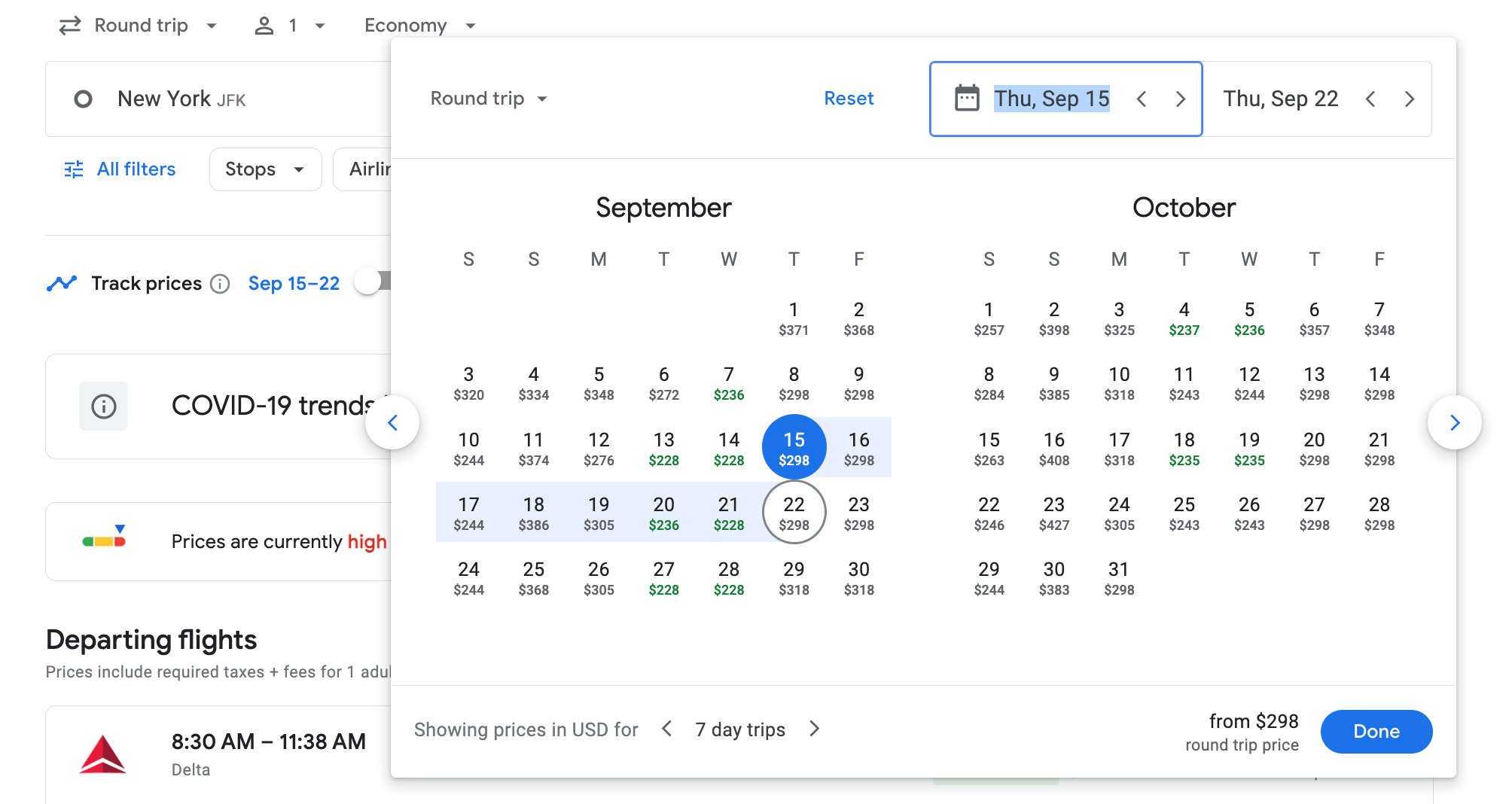
Another way to view the cheapest dates is to click the date grid option. This will again show the cheapest dates in green, and you can easily line up different outbound and inbound options to see if the cheapest dates work for you.
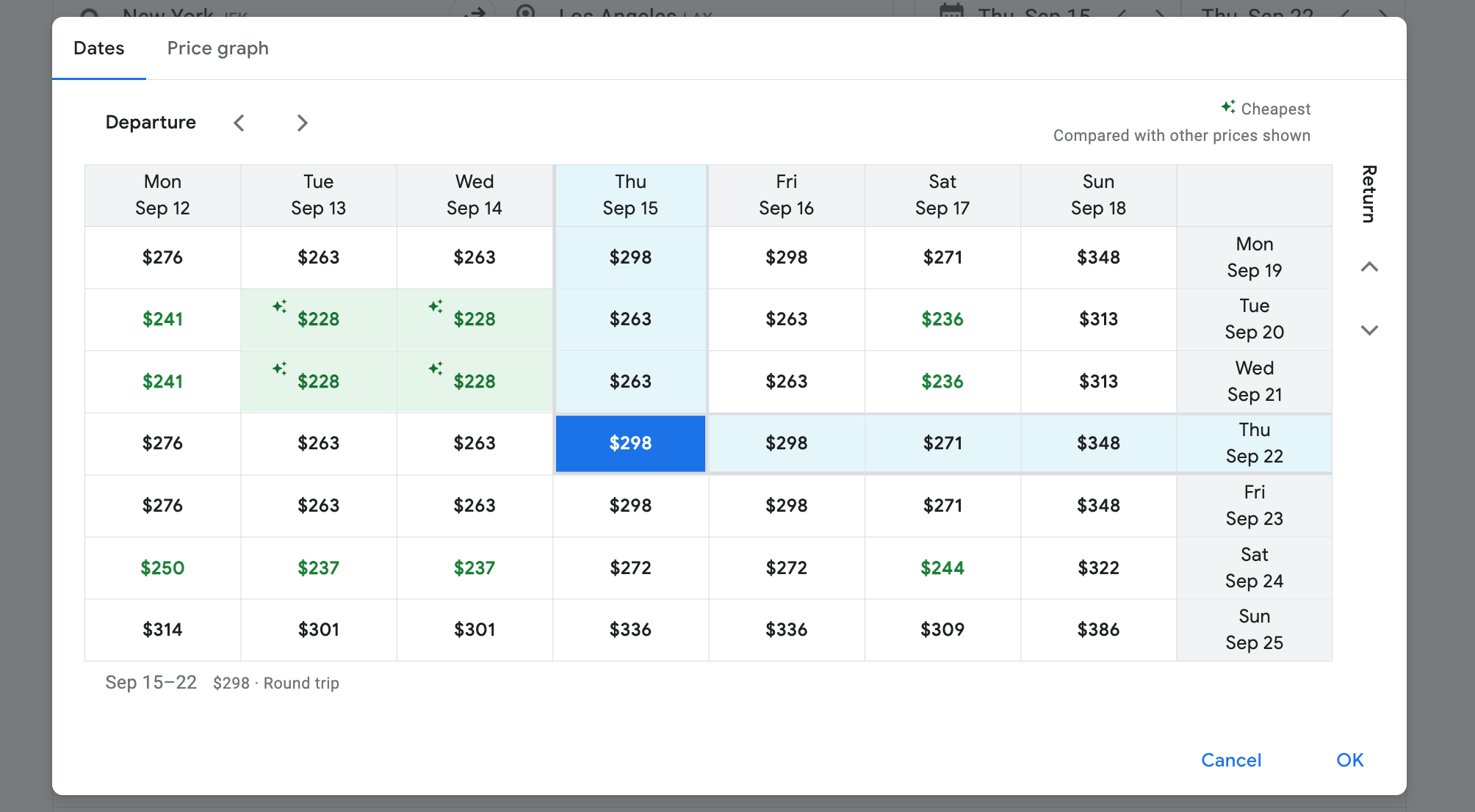
You’ll often find that the cheapest flight isn’t necessarily the best or most convenient route. Google will show you those lowest prices, but prioritize better routes before it.
In this example, Google Flights prioritizes slightly higher fares as the “best flights” search results because they include a full-size carry-on bag.
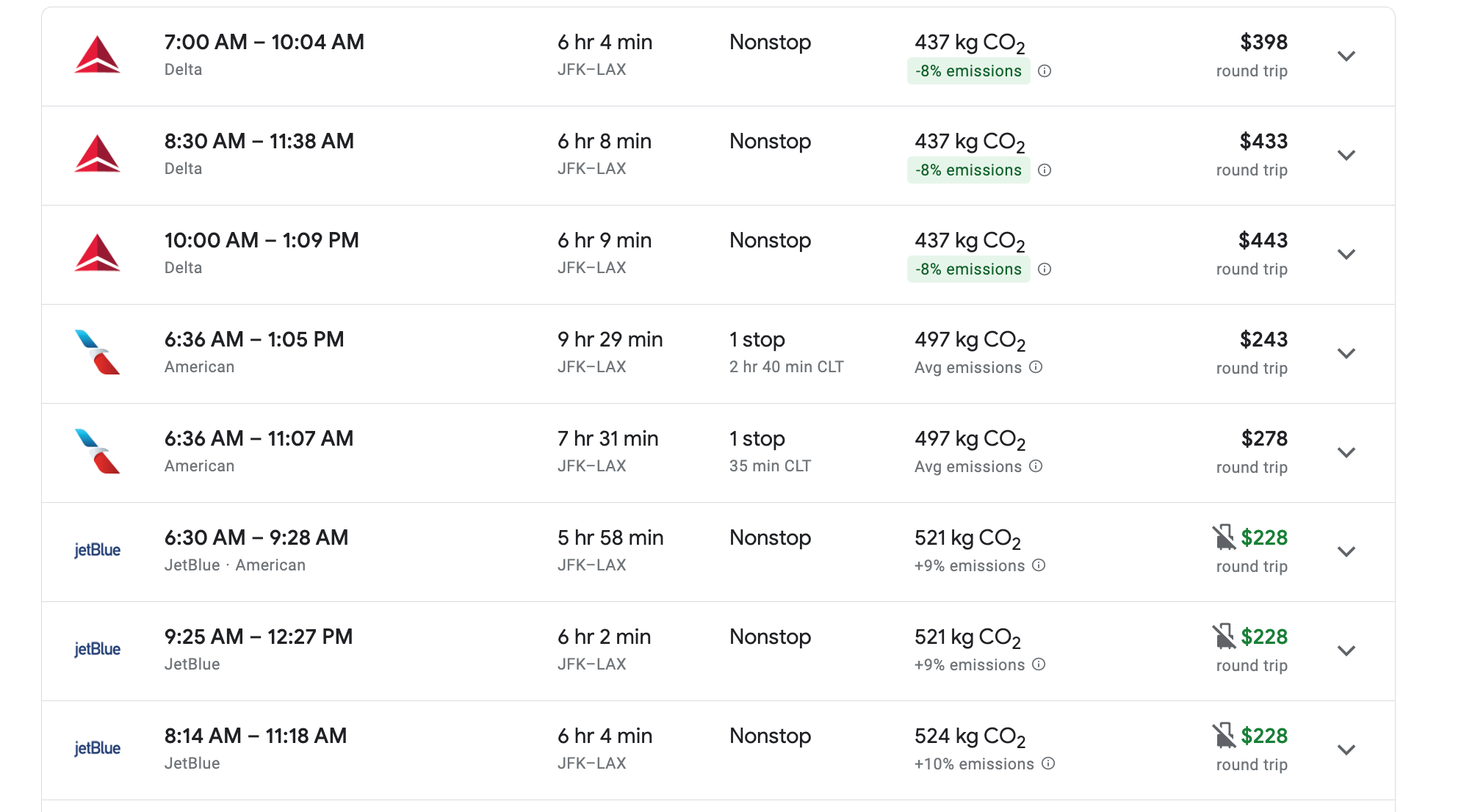
How to set a price alert for yourself
After all that diligent work, give yourself a pat on the back. You’ve likely found the best option for you.
Some people are ready to book immediately, but most of us might need a day or two to solidify our plans with our fellow travelers or with work. Never fear: Google will help you track your flight and even tell you when the price goes up or down.
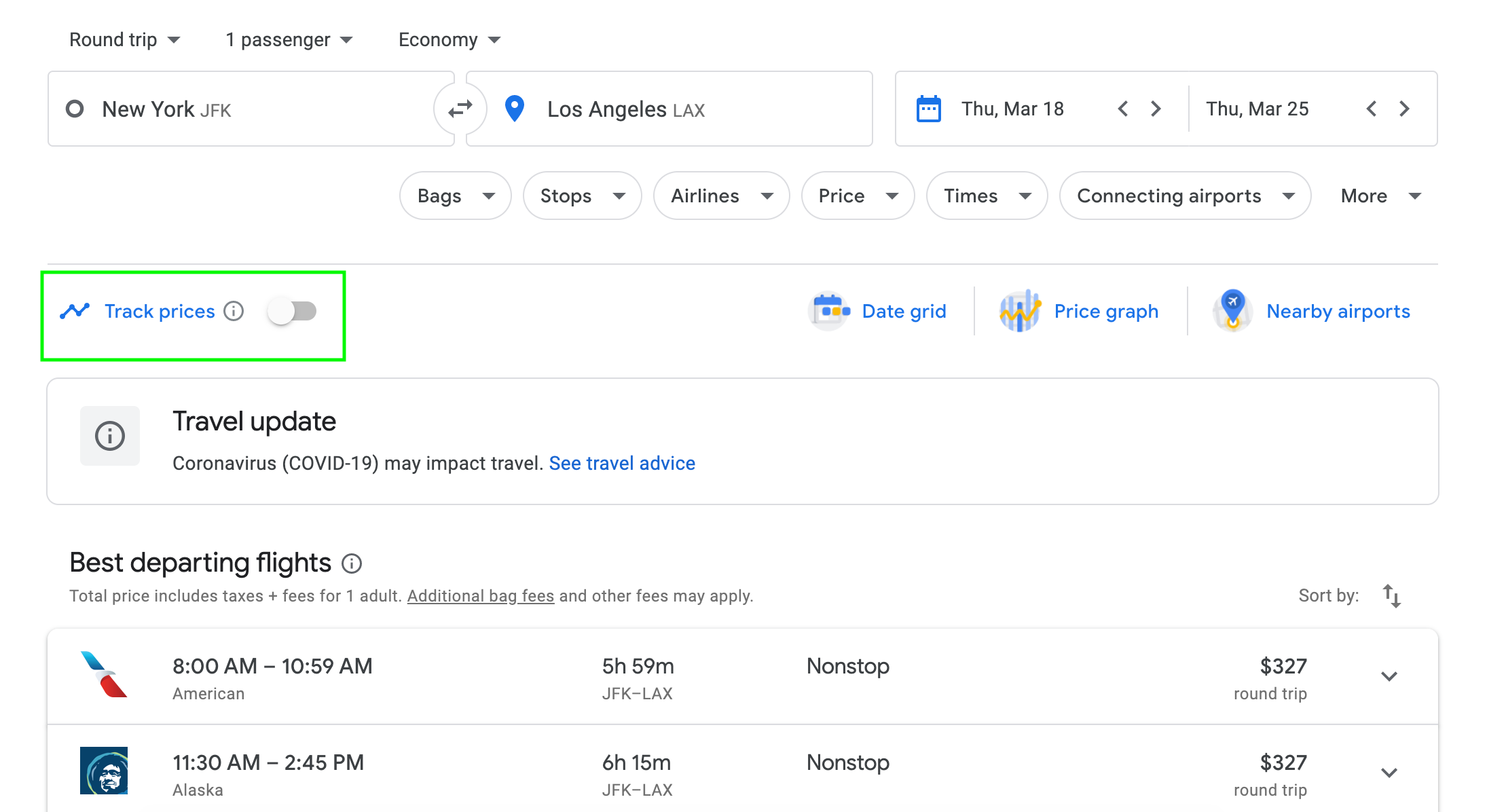
Immediately above your search results, a little toggle reads “Track prices” (boxed in green in the screenshot above).
Click on that — and log in to your Google account if necessary — and Google Flights will send price alerts directly to your inbox.
If you have booked a refundable or changeable fare, you may want to switch this on even after you’ve booked. You will be alerted if the price goes up or down, so you can feel comfortable knowing you are getting the best deal. The screenshot below shows part of the list of flights I’m currently tracking.
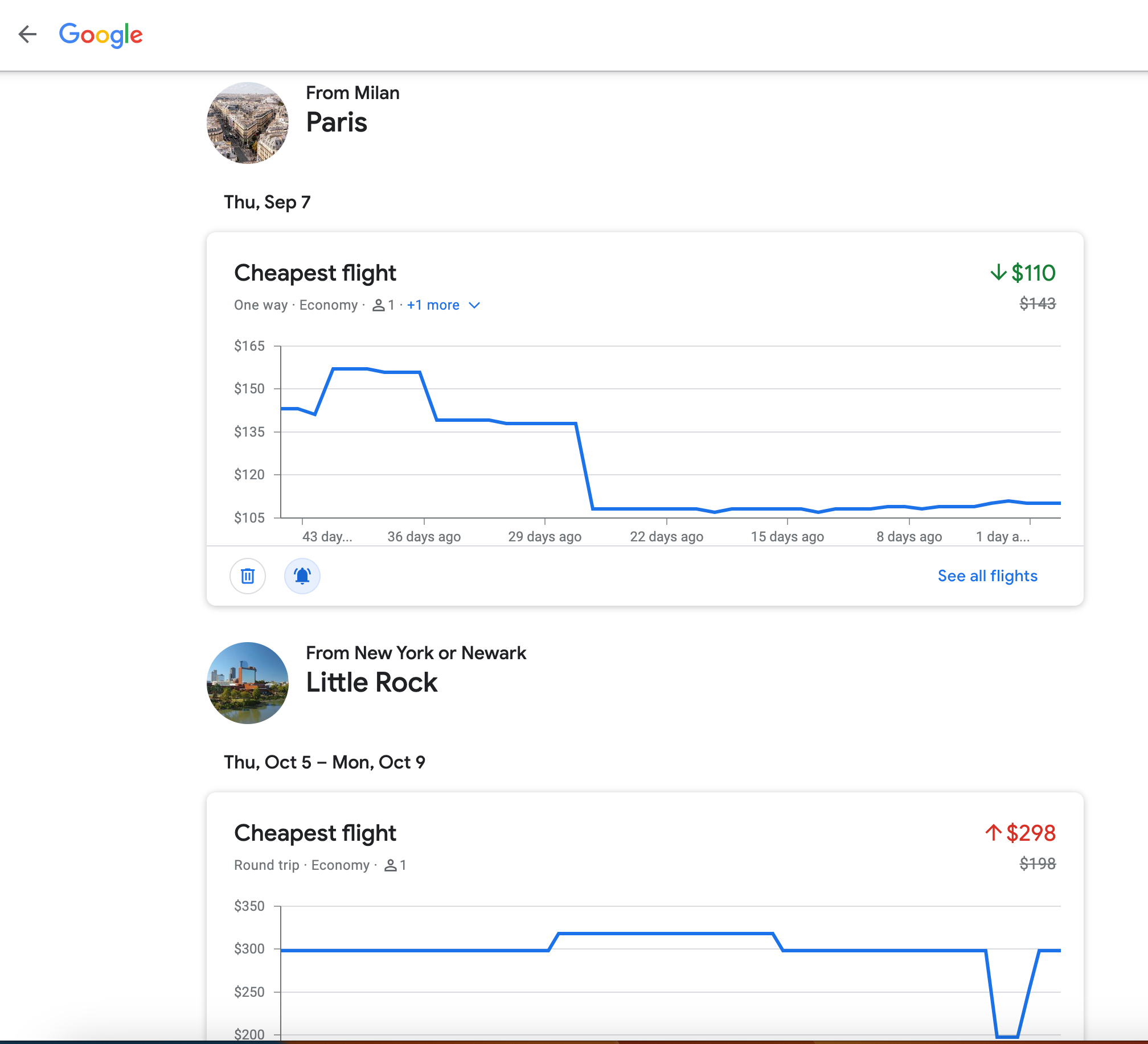
Related: How to avoid airline change and cancellation fees
How to search multiple airports at once
Sometimes, you’re willing to land or depart a bit farther away in order to find a better flight deal. Google Flights can help reward that flexibility. In fact, you can enter as many as five departure or arrival airports on Google Flights.
Let’s say you live in New York City, where you have three major airports from which to choose. You want to fly to Southern California, which is easily accessible from multiple airports as well.
There are two ways to run this search:
- Type in your city name and let Google offer suggestions: This works for many major metro areas. As soon as I type in New York, I see several of the major airports: Newark Liberty International Airport (EWR), LaGuardia Airport (LGA) and JFK. Sometimes, you’ll even see New York Stewart International Airport (SWF) near Newburgh — about 60 miles north of Manhattan — as an option.
- Manually type in your airport codes or names: Some cities won’t show you all the logical potential airports. For Southern California, you will have to manually type in the names or codes of each airport in the area for some searches. Don’t forget San Diego International Airport (SAN) as a potential option.
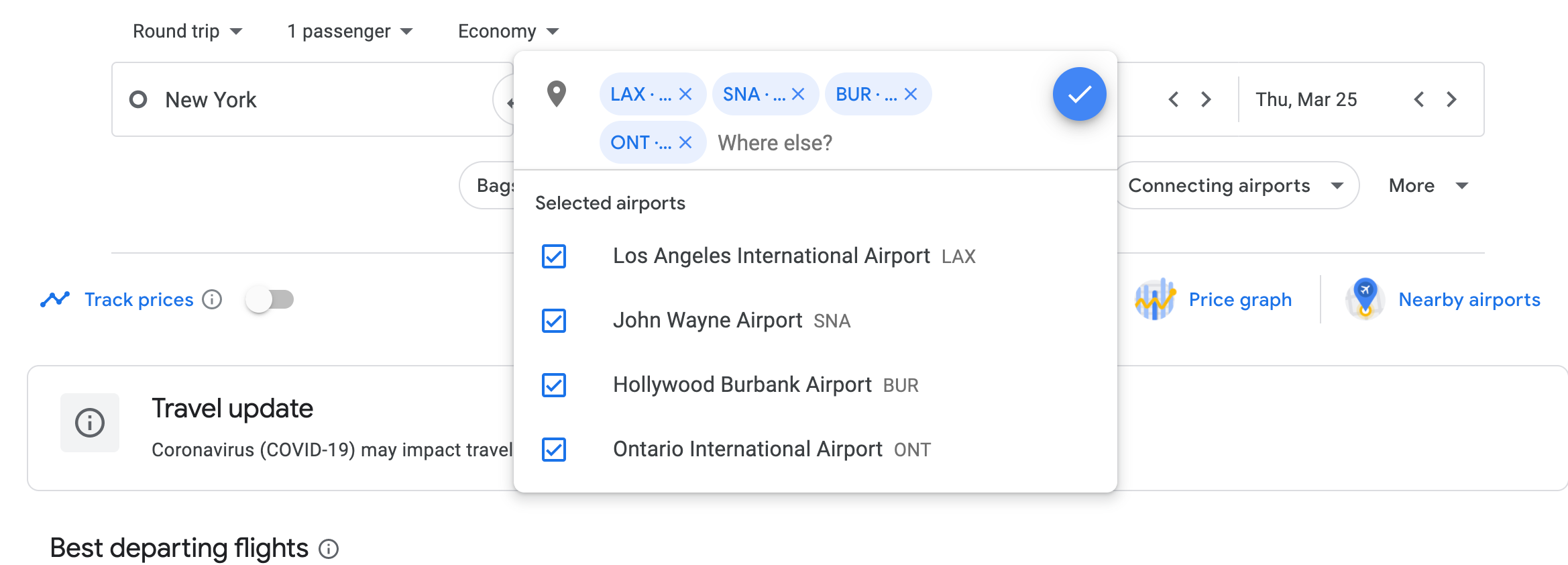
Voila: The cheapest option for March 18-25 is a nonstop, round-trip flight from EWR to LAX for $258 in United basic economy.
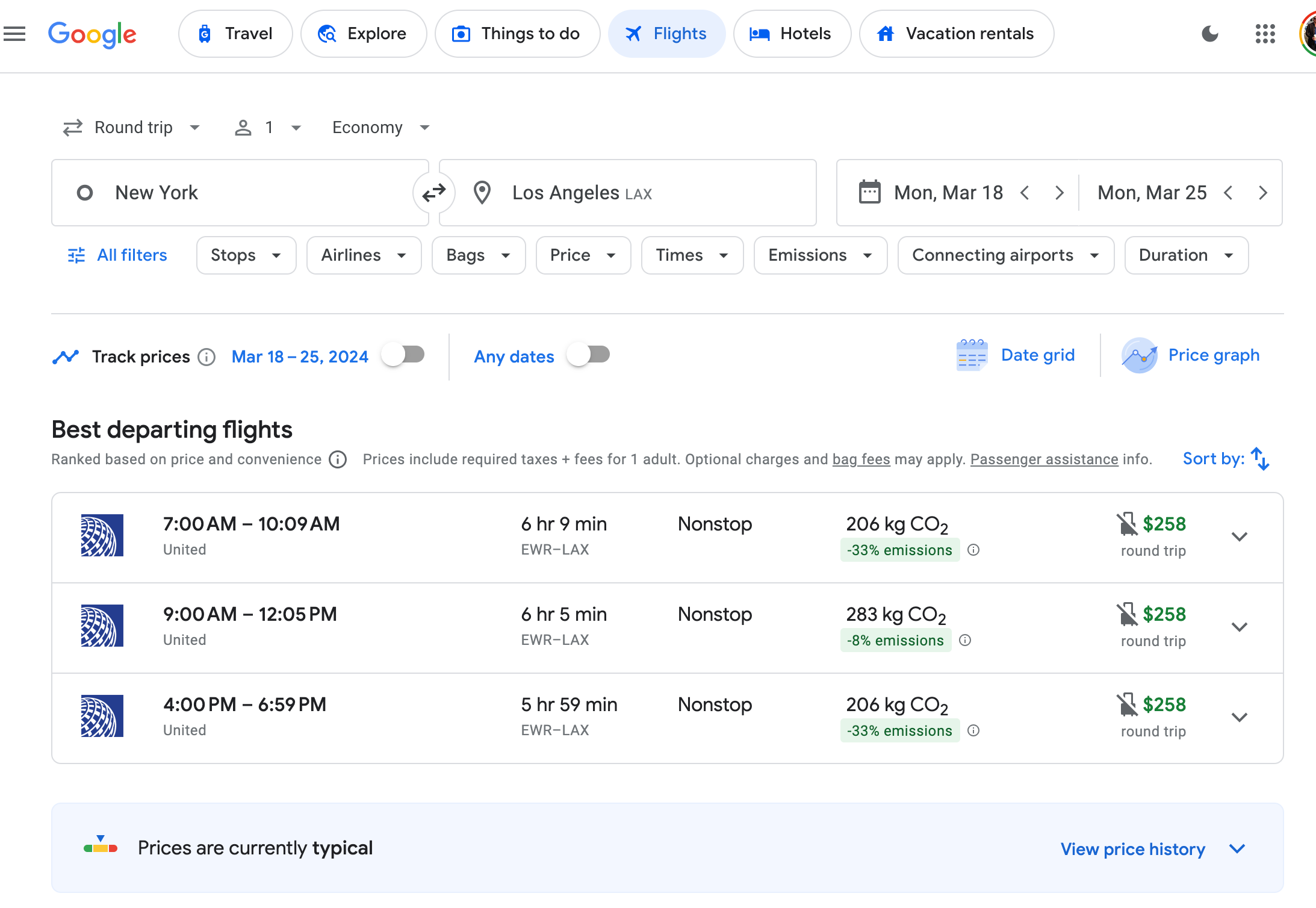
How to check for carry-on bag policies
I don’t care what anyone says: Low-cost carriers can be fantastic for finding great deals.
However, if you’re a heavy packer, you’ll need to plan ahead. Many airlines cut costs by charging extra for bags. You’re used to this with major airlines, but some ultra-low-cost airlines will even charge you for carry-ons larger than a backpack or a purse.
It can be difficult to track which airlines charge what, but Google Flights can also help with that.
Basic economy flights will show on the search results page, with the little “no luggage” icon next to the price tag.
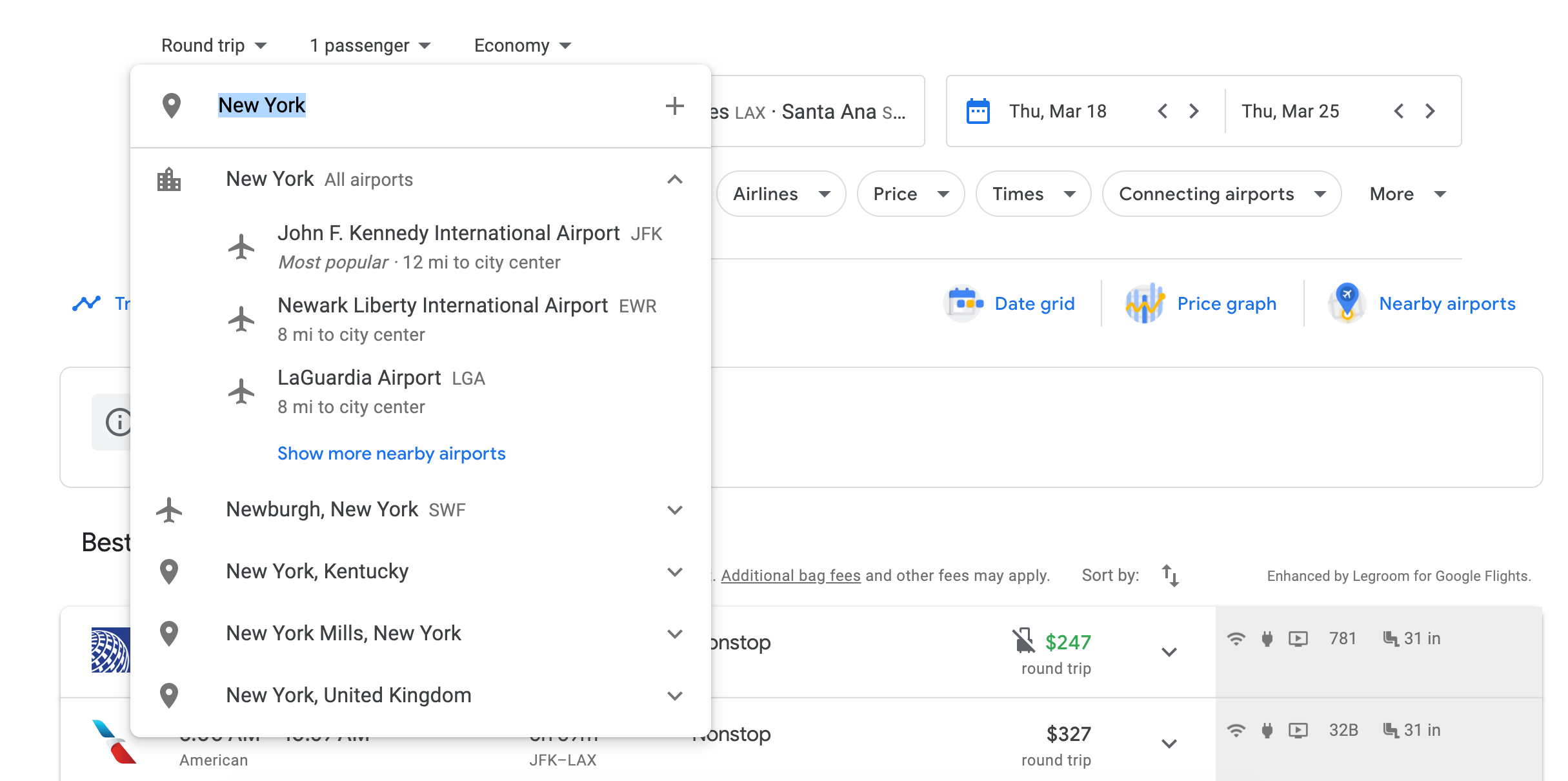
When I click through to the final booking page, Google will remind me that I’m booking a basic economy flight; it’ll show my current price and its limitations while also displaying economy and first-class booking options next to it.
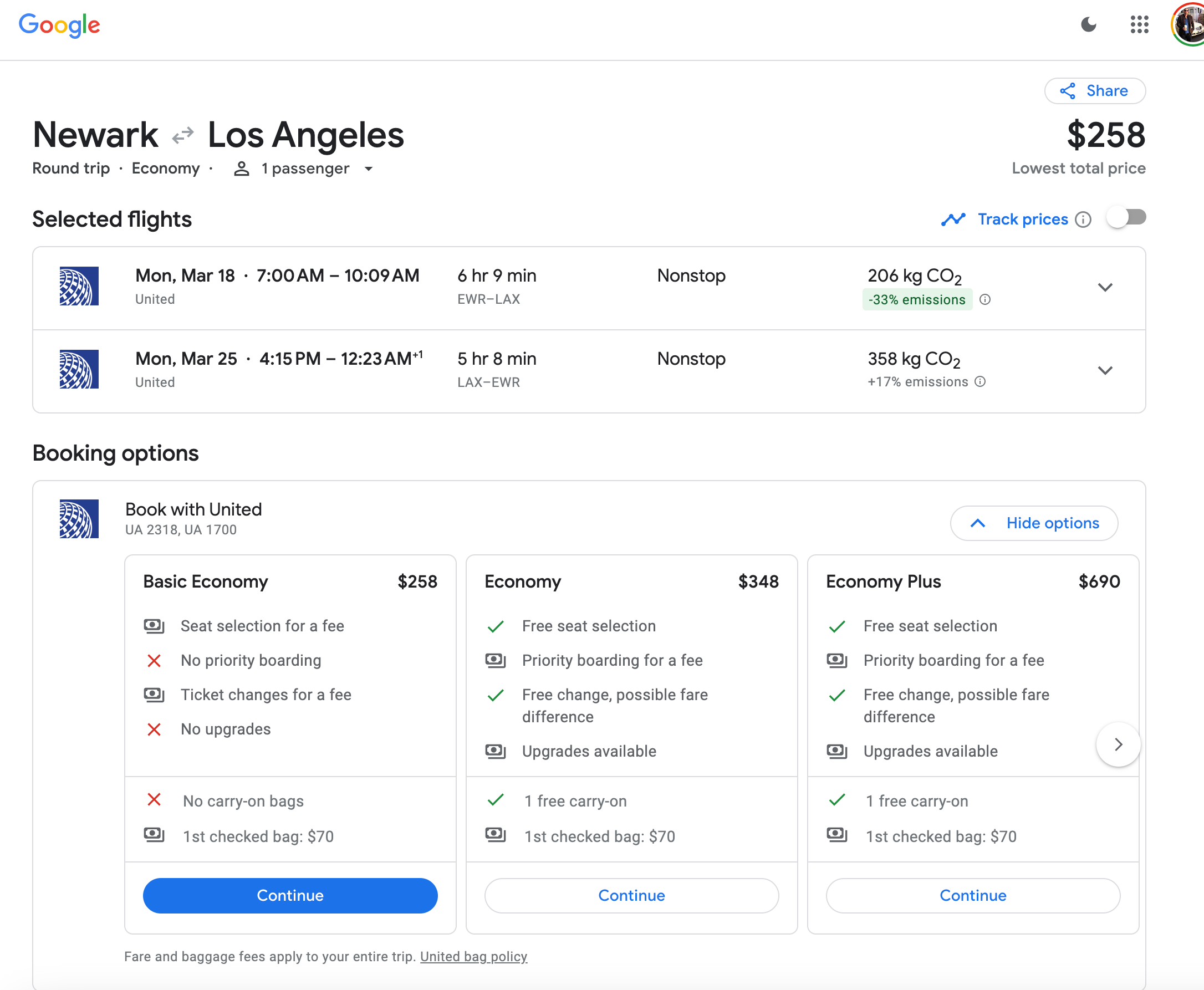
Google Flights Travel
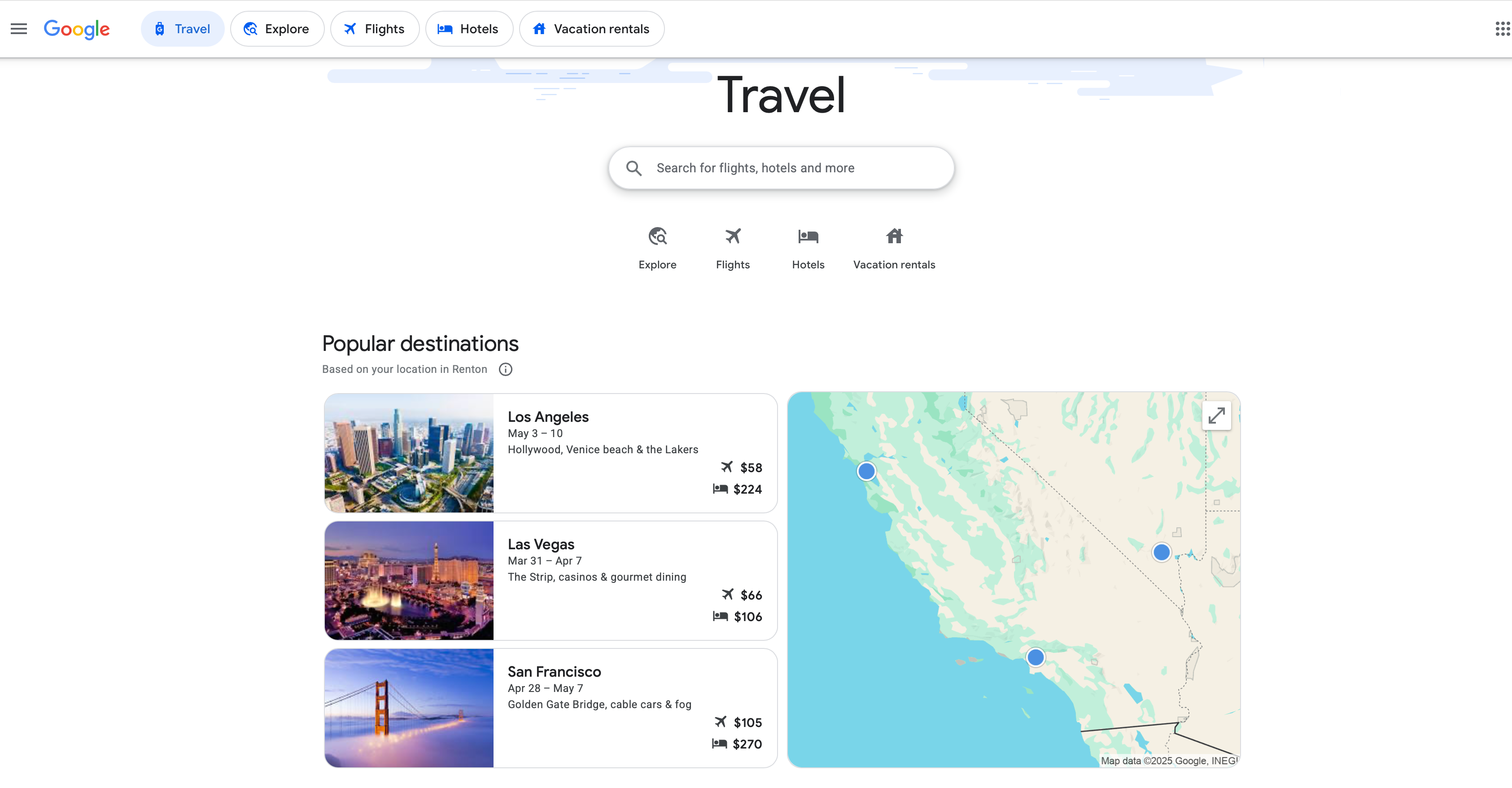
You may also notice a “Travel” button on the Google Flights toolbar. This tool can help plan your trip more cohesively, with itinerary suggestions for your next trip.
It will also show potential trips, with some suggested itineraries based on your current location. It will provide suggestions based on popular destinations and may incorporate destinations you’ve Googled in general. Perhaps you have searched for “When is the best time to visit Hawaii?” Google Flights may show you suggestions to help you continue planning that trip.
A previous feature that collated your upcoming travel has been discontinued.
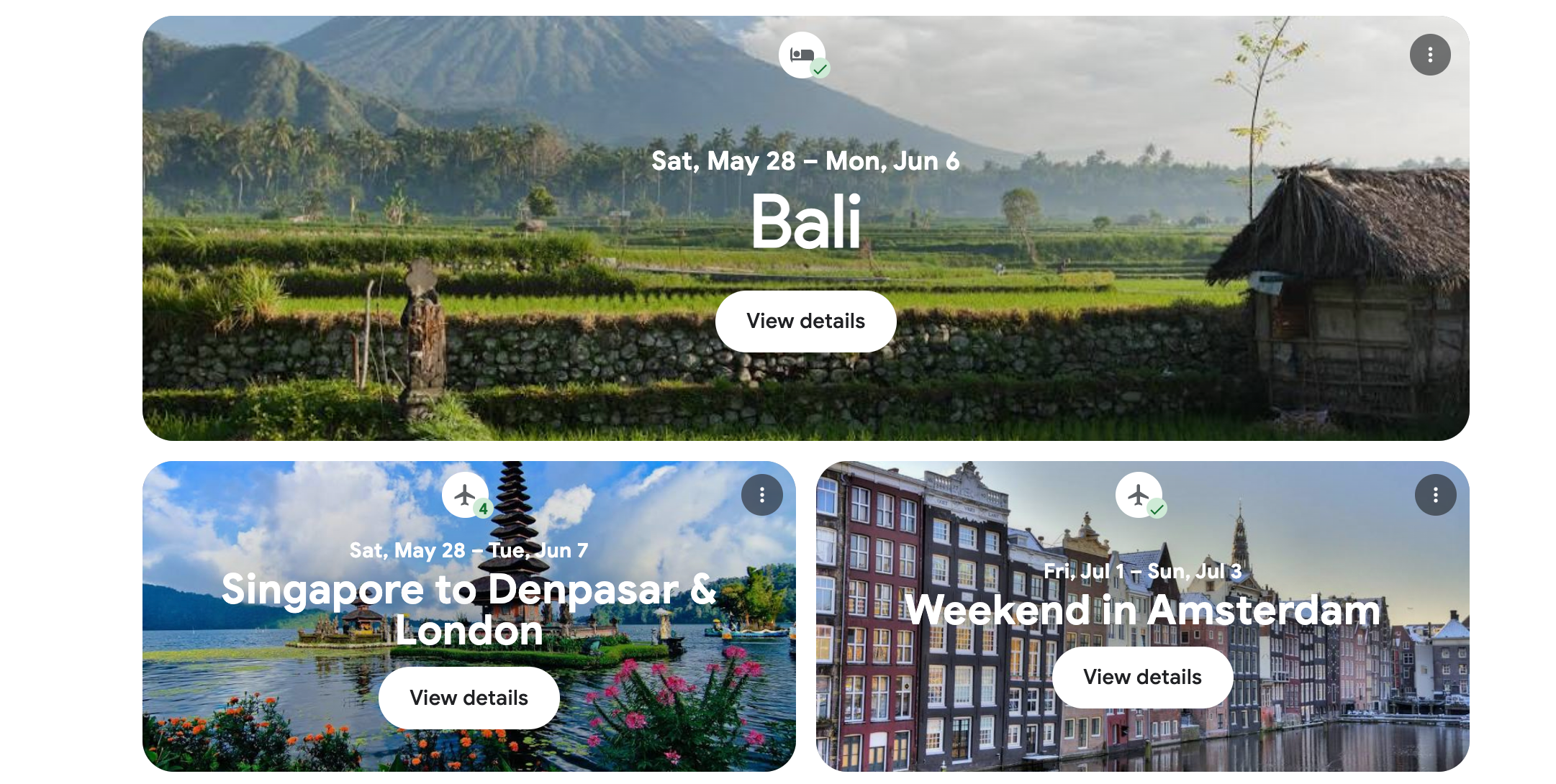
How to find the best getaway deal
This function is similar to the previous tip but focuses on another aspect of your search. Start by clicking the “Explore” button on the toolbar.
If you know you want to get away on specific dates — let’s say the second week of October — but don’t have a specific destination in mind, use Google’s open-ended search functionality to find good flight deals within your window of availability.
In the example below, I picked a long weekend in October and set my hometown of New York as my departure airport. Instead of specifying a destination, I just left it open-ended. You can give Google a hint by typing “Europe” or “Caribbean” to narrow your search results to a specific region.
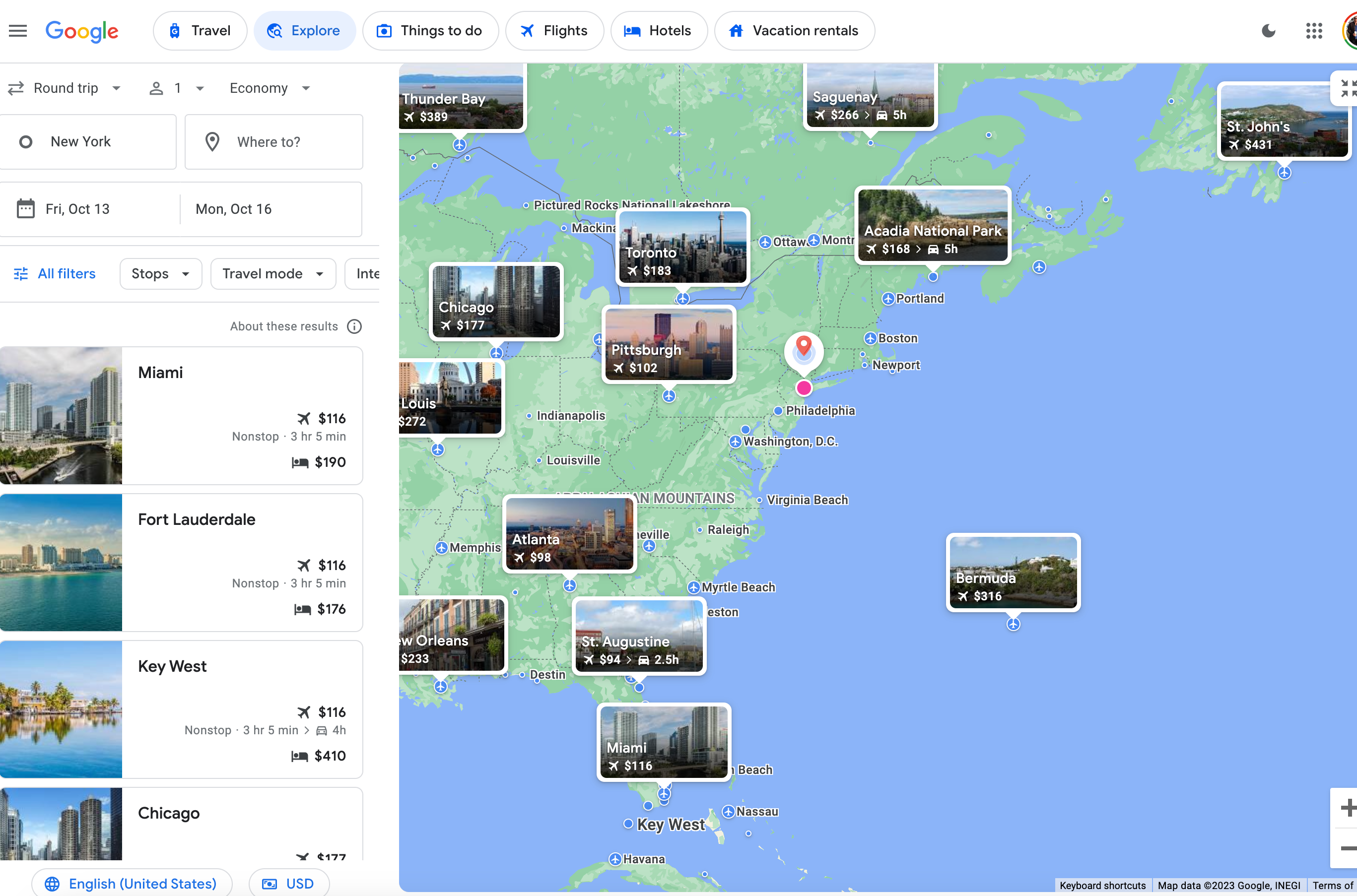
If I zoom in closer on the map, the system recalibrates and shows me more destinations and price points within the updated map view.
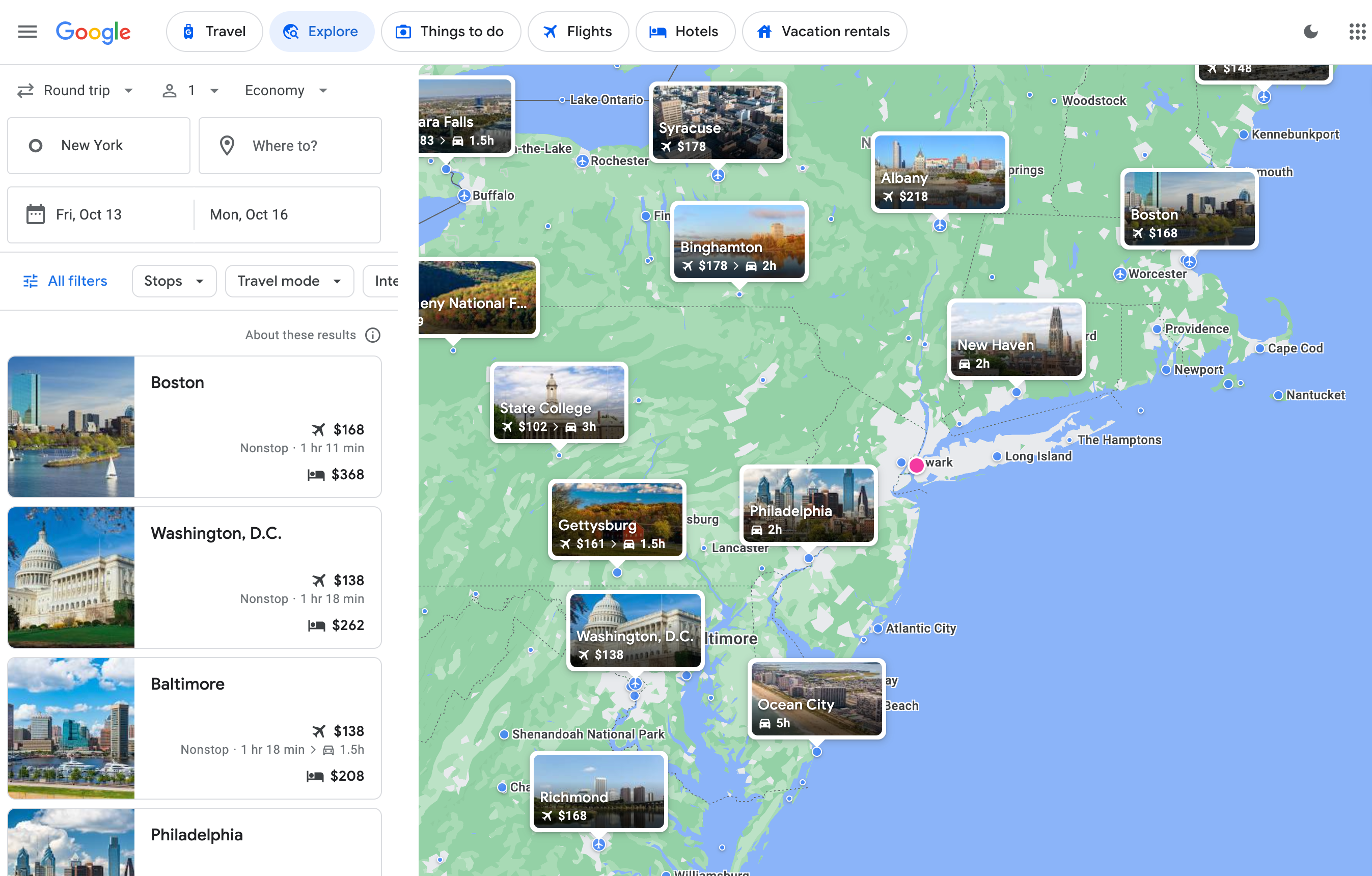
If I zoom out for a world view, I’ll see the best-priced destinations of note around the globe.
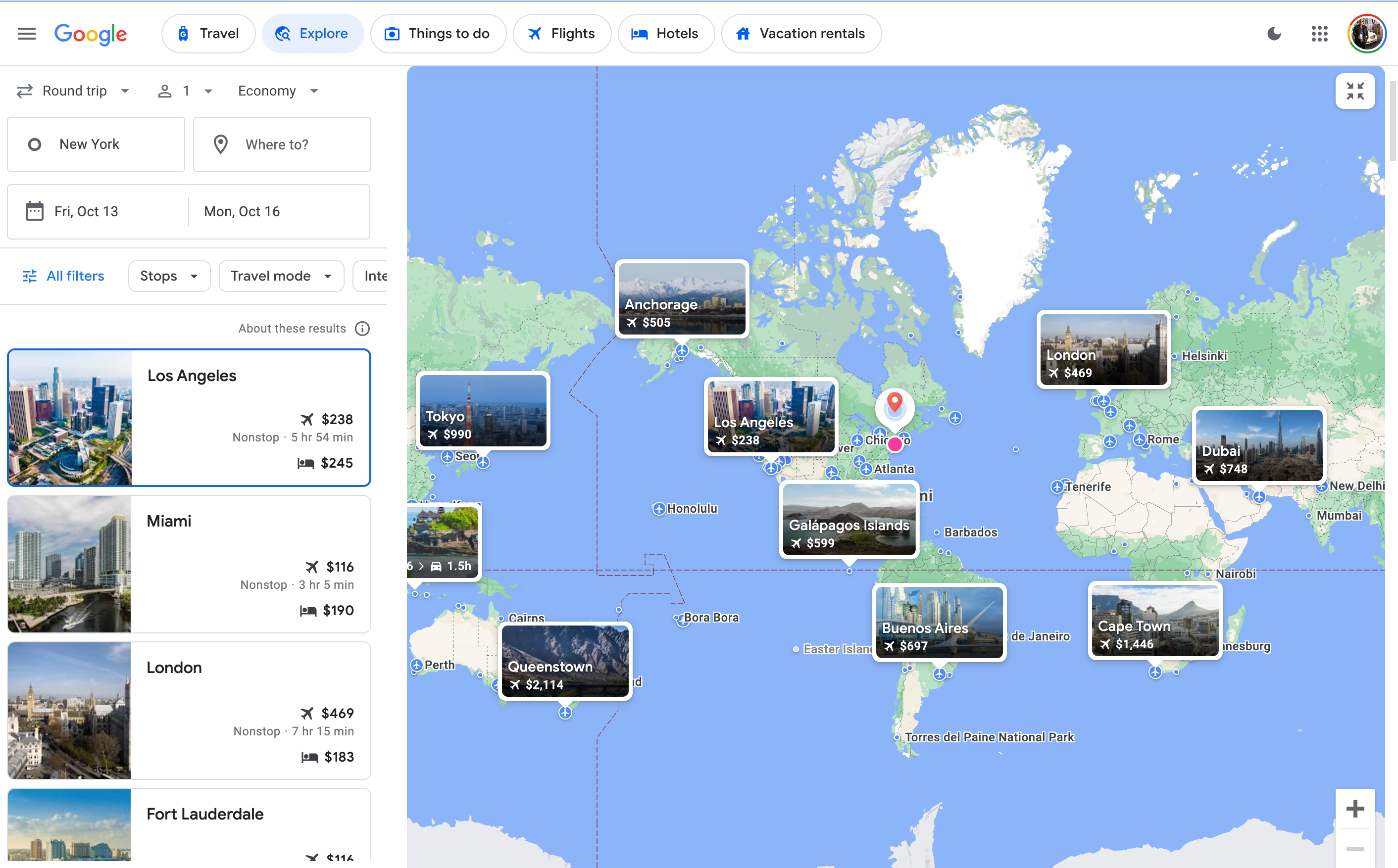
I can also force the algorithm to show me price points for a specific region.
For example, the world map above doesn’t show me many deals for Australia, South America or Africa. However, if I zoom in on Australia, I see more than half a dozen options on the continent and more than a dozen in “surrounding” areas.
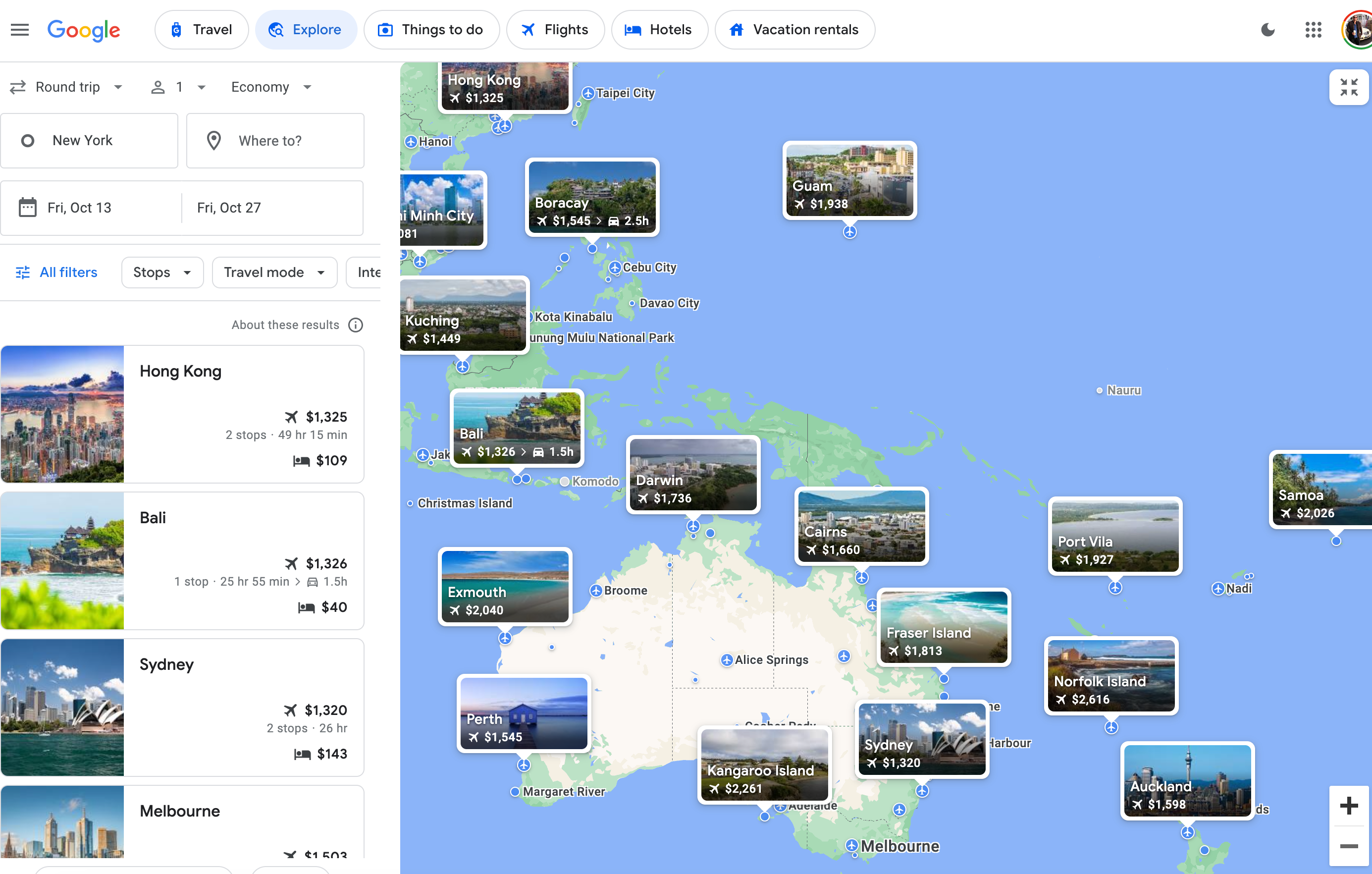
Related: Safaris, cities and lots of elephants: How I returned to South Africa using points, miles and cash
Bottom line
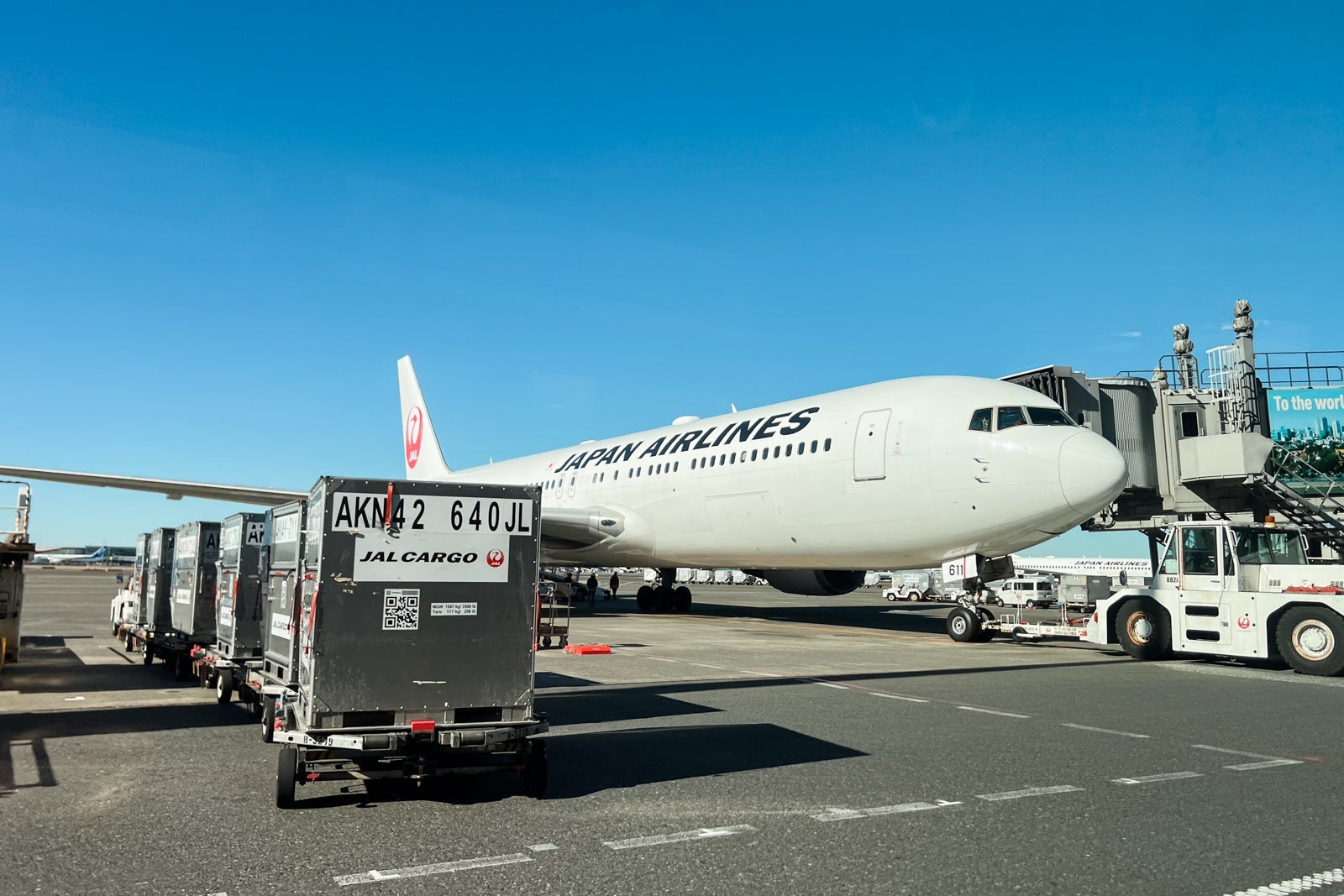
Google Flights is an incredibly powerful tool that the TPG team uses daily to price airfare. It can help you quickly find the best flights for your travel, but it can also track prices and let you know if you are getting a good deal. It can also help you plan trips and find hotels and activities.
It’s one of my favorite tools to find deals and new places to visit. Add it to your own travel toolbox; I promise it will become one of your favorites, too.
Related reading:

